
Article Summary: Tennessee Landmarks
Tennessee Landmarks. More Than Just Parks has 20 incredible must-see sites for you to visit.
There’s so much more to this exciting place than Rocky Top. In this article, we’ll familiarize you with the incredible landmarks located in the Volunteer State.
We’ve got incredible places, iconic memorials, fascinating museums, epic monuments and so much more.
We’re going to give you our list of the Top 20 Landmarks In Tennessee.
So, What Is A Landmark?
Well, it’s a place of “a special character or special historical or aesthetic interest or value as part of the development, heritage, or cultural characteristics of a city, state, or nation.”
Why visit these places? Because landmarks connect us to the past. Through visiting these wonderful places where history occurred we find our roots. It allows us to feel like we are a part of something much bigger than ourselves.
And, speaking of history, did I mention that I taught the subject? I spent a lifetime teaching about the history behind many of these amazing sites. Then I got to see them firsthand. And now I’m sharing the fascinating stories of these places with you. It doesn’t get any better than that!
So, without further ado, let’s dive in.
Table of Contents: Tennessee Landmarks
Tennessee Landmarks
Some Fascinating Facts About Tennessee
Here are some fascinating facts about Tennessee:
- Nicknamed the “Volunteer State”: Tennessee earned this nickname during the War of 1812 due to the large number of volunteers from the state who joined the military.
- Birthplace of country music: The city of Bristol, Tennessee, is considered the birthplace of country music. In 1927, the “Bristol Sessions” were recorded, featuring artists like The Carter Family and Jimmie Rodgers, and they had a significant impact on the development of country music.
- Great Smoky Mountains National Park: Tennessee is home to a significant portion of the Great Smoky Mountains National Park, which is the most visited national park in the United States. It offers stunning scenery, diverse wildlife, and numerous outdoor activities.
- Tennessee whiskey: Tennessee is known for its distinct style of whiskey, known as Tennessee whiskey. The most famous brand is Jack Daniel’s, which is produced in Lynchburg, Tennessee.
- Elvis Presley’s Graceland: Memphis, Tennessee, is where you can find Graceland, the former home of the legendary musician Elvis Presley. It is one of the most visited private homes in the United States, attracting fans from around the world.
- Oak Ridge National Laboratory: Located in Oak Ridge, Tennessee, it is the largest science and energy national laboratory in the United States. The facility conducts cutting-edge research in various fields, including nuclear energy, materials science, and supercomputing.
- The “Athens of the South”: Nashville, the capital of Tennessee, is often referred to as the “Athens of the South” due to its rich cultural and educational institutions. The city is known for its vibrant music scene, including the famous Grand Ole Opry, as well as being home to several universities.
- The Tennessee Valley Authority (TVA): The TVA was established in 1933 as a federal agency to address the economic and environmental challenges of the Tennessee Valley region. It was one of the most ambitious infrastructure projects of the New Deal era, providing electricity, flood control, and economic development to the area.
- Natural wonders: Tennessee is blessed with numerous natural wonders, including the stunning Ruby Falls, an underground waterfall located in Chattanooga, and the scenic Natchez Trace Parkway, a historic road that stretches across the state.
- Civil Rights history: Tennessee played a significant role in the Civil Rights Movement. The National Civil Rights Museum, located in Memphis at the site of the Lorraine Motel where Martin Luther King Jr. was assassinated, provides a comprehensive history of the movement.
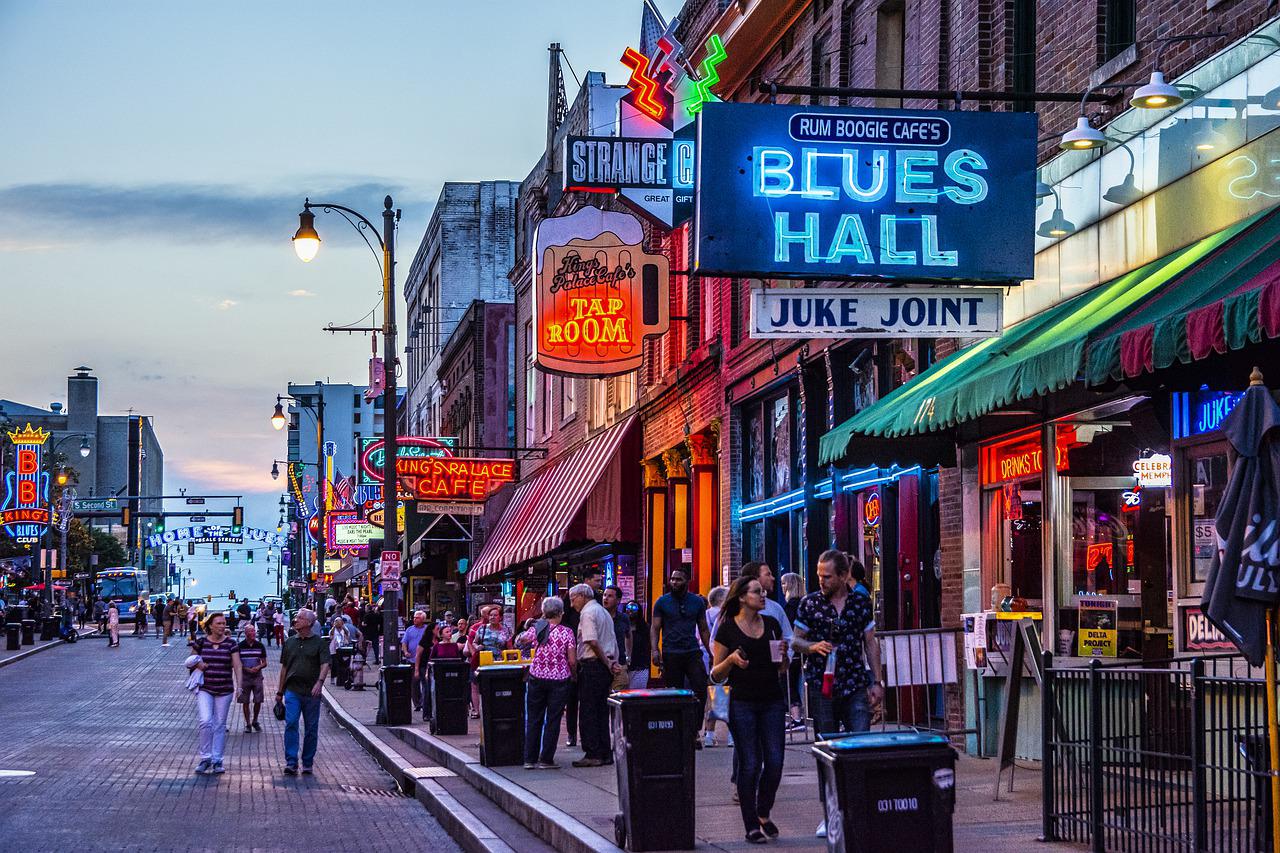
Top 20 Tennessee Landmarks
20. Tennessee State Capitol
Tennessee is known for its music scene, high-quality whiskey, and home to the Great Smokies. Country music artists and singers such as Elvis Presley and Dolly Parton hail from Tennessee, and the state has been home to many other popular musicians over the years.
It’s also home to some amazing historic sites which celebrate these things and so much more. At More Than Just Parks, we’re excited to share our list of the Top 20 Tennessee Landmarks with you.
And we’re kicking off our list at #20 with the Tennessee State Capitol.

A Short History Of The Tennessee State Capitol
In 1806, the Tennessee General Assembly authorized the selection of a permanent capital for the state. Five commissioners were appointed to choose a location, and they ultimately selected a site along the Cumberland River for the new capital city, which would be named Nashville.
The design of the Tennessee State Capitol was entrusted to architect William Strickland, who is considered one of the leading architects of his time. He designed the Greek Revival-style building, drawing inspiration from classical Greek architecture.
Construction of the Capitol building began in 1845. The building was constructed using local limestone and completed in 1859, although various additions and renovations have been made over the years.
During the American Civil War, Tennessee was divided, with some citizens supporting the Union and others favoring the Confederacy. In February 1862, Nashville fell to Union forces, and the State Capitol became a military headquarters for the Union Army.
Historic Moments
After the Civil War, Tennessee underwent a period of Reconstruction. The Capitol played a significant role during this time as the state government worked towards rebuilding and establishing new policies.
The Tennessee State Capitol has witnessed several historic moments. In 1920, it became the site of the pivotal vote to ratify the 19th Amendment to the United States Constitution, granting women the right to vote. This made Tennessee the crucial 36th state needed to ratify the amendment.
The Tennessee State Capitol is renowned for its architectural beauty. The central feature is the majestic cupola, topped by a gilded statue of the Roman god Mercury. The interior features stunning artwork, including portraits of prominent Tennesseans and historical murals.
Over the years, efforts have been made to preserve and restore the Capitol building to its original grandeur. In the 1980s, a comprehensive restoration project took place, ensuring the building’s historical integrity and beauty.
The Tennessee State Capitol serves as a symbol of state government and democracy. It houses the chambers of the Tennessee General Assembly and the offices of the governor and other state officials.
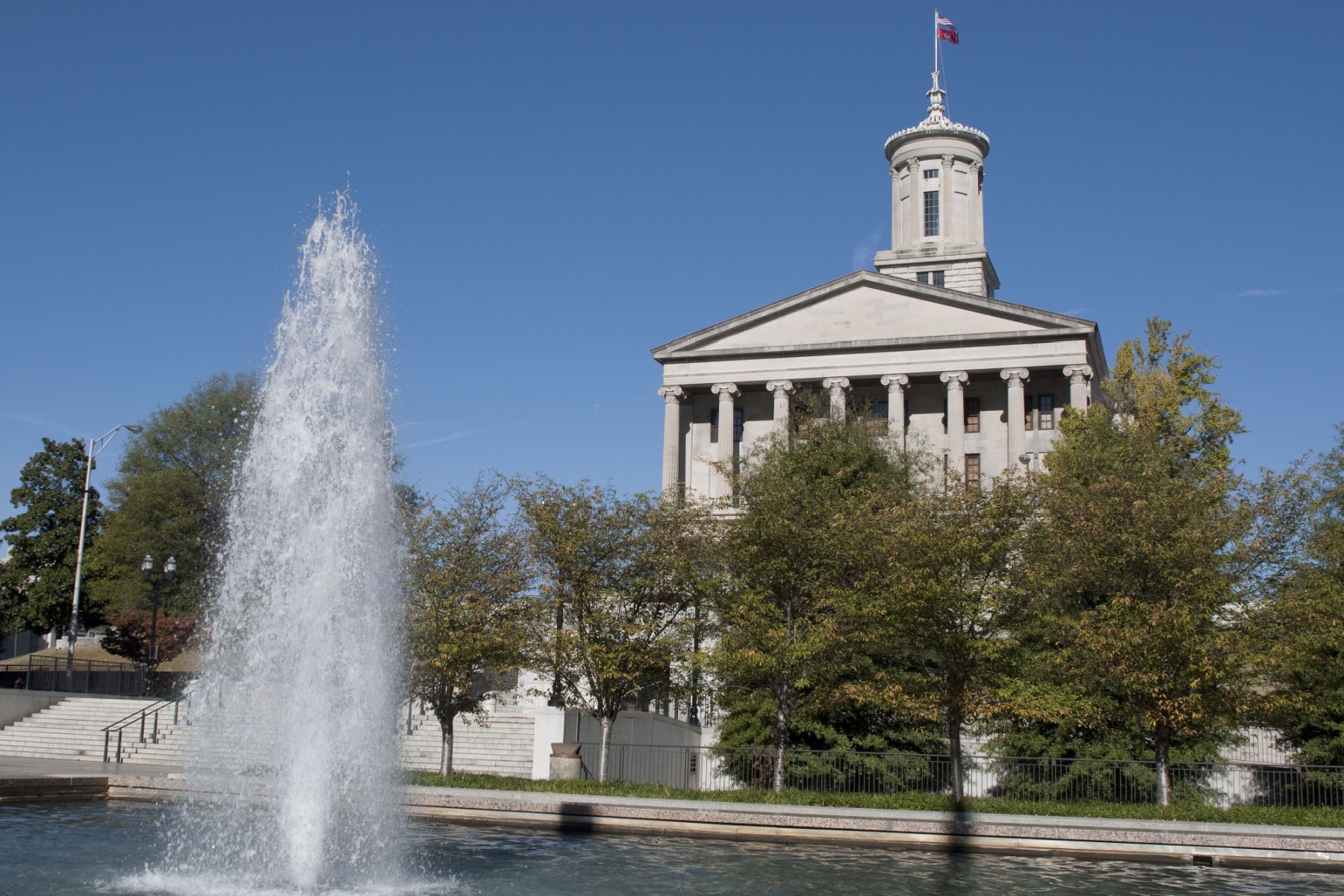
19. Dollywood
Our Tennessee landmark spans 160 acres in the Great Smoky Mountains. It offers more than 50 world-class rides, high-energy entertainment, award-winning dining and the friendliest theme park atmosphere in the world.
At #19 on our list of the Best Tennessee Landmarks is Dollywood.

A Rebel Railroad
Dollywood was originally opened in 1961 as “Rebel Railroad,” a small tourist attraction featuring a steam train ride. In 1976, country music legend Dolly Parton, who grew up in the nearby area, partnered with Herschend Enterprises to rebrand and expand the park. It was then renamed “Dollywood” as a tribute to Dolly Parton.
Dollywood is nestled in the beautiful Smoky Mountains, providing a picturesque backdrop for the park. The park covers a sprawling area of approximately 150 acres and is surrounded by natural beauty.
It celebrates the spirit and culture of the Appalachian region while incorporating Dolly Parton’s influence and charm. The park offers a variety of thrilling rides, family-friendly attractions, live entertainment, and shows. There are roller coasters, water rides, and traditional amusement park attractions suitable for all ages.
Dollywood exudes a warm and welcoming atmosphere, known for its Southern hospitality. The park showcases the region’s rich heritage through its architecture, music, crafts, and traditional Appalachian cuisine. Visitors can experience live music performances, traditional crafts demonstrations, and even taste Southern dishes like fried chicken and homemade biscuits.
World Class Entertainment
Dollywood is renowned for its world-class entertainment and shows. The park features a lineup of daily performances, including musical concerts, Broadway-style productions, and seasonal festivals. Dolly Parton herself occasionally makes appearances or performs special concerts at the park.
It’s home to numerous skilled craftsmen and artisans who showcase their talents. Visitors can observe traditional crafts like blacksmithing, glassblowing, woodcarving, pottery, and more. The park provides a platform for these artisans to preserve and promote the Appalachian craft heritage.
Dollywood operates the Great Smoky Mountains Railroad, a scenic train ride that takes passengers on a journey through the Smoky Mountains’ beautiful landscapes. The train ride offers stunning views of the surrounding nature and provides a unique experience for visitors.
It hosts a variety of seasonal festivals throughout the year. These festivals celebrate holidays like Christmas, Harvest, and Spring, featuring special decorations, themed shows, parades, and unique entertainment offerings.
Adjacent to Dollywood is Dollywood’s Splash Country, a water park that offers a refreshing escape during the hot summer months. It features water slides, lazy rivers, wave pools, and other water attractions for visitors to cool off and have fun.
Dollywood’s impact extends beyond entertainment. The park actively engages in philanthropic initiatives, such as the Imagination Library program, founded by Dolly Parton, which provides free books to children to promote literacy.

Dolly Parton at Dollywood | Courtesy of Wikimedia Commons
18. Rock City
Our next Tennessee landmark is only six miles from downtown Chattanooga. It’s 1700 feet above sea level, with a 100-foot waterfall that cascades down the mountain and the famous Swing-A-Long bridge that spans nearly 200 feet.
At #18 on our list of the Best Tennessee landmarks is Rock City.
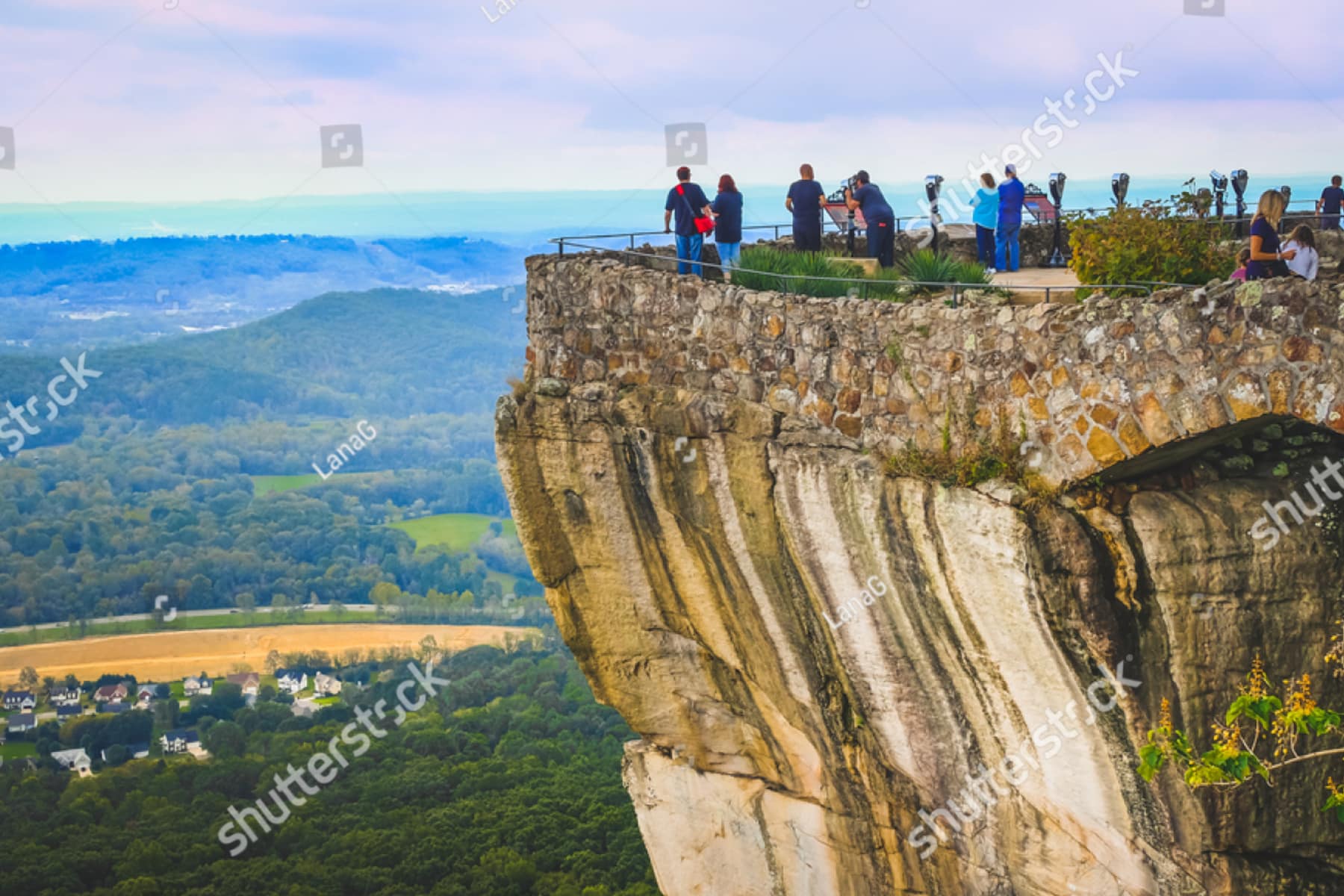
A Short History Of Rock City
Rock City was founded in 1932 by Garnet Carter and his wife Frieda. Inspired by Frieda’s vision of creating a garden retreat, they developed the area into a natural rock garden and began opening it to the public. They chose the name “Rock City” due to the massive ancient rock formations found on the property.
To attract visitors, Garnet and Frieda Carter created a unique marketing campaign. They enlisted Clark Byers, a painter, to travel across the country and paint “See Rock City” on barns and other structures, creating one of the most iconic advertising campaigns in history. These distinctive advertisements still exist today, becoming a recognizable symbol.
Rock City is renowned for its stunning natural beauty and unique rock formations. Visitors can explore a trail that winds through the gardens and offers breathtaking panoramic views of the surrounding mountains, as well as fascinating geological features like Lover’s Leap and Fat Man’s Squeeze.
In the 1940s, Frieda Carter developed Fairyland Caverns, a series of enchanting caves featuring scenes from classic fairy tales, illuminated by blacklight. Alongside Fairyland Caverns, Mother Goose Village was created, showcasing whimsical nursery rhyme characters in a charming setting.
Legacy & Preservation
After Garnet and Frieda Carter passed away, their children continued to manage and preserve Rock City. In 1969, it was designated as a National Historic Landmark due to its cultural significance and unique natural features.
Over the years, Rock City has formed partnerships with other attractions and organizations to enhance the visitor experience. It has collaborated with the nearby Incline Railway, creating combined ticket options for tourists, and has hosted events and festivals, further promoting the region’s tourism.
Rock City has evolved over time to include additional attractions and amenities. It now features a bird sanctuary called the “See Seven States” panoramic view, which provides visitors with an opportunity to see seven U.S. states from a single vantage point. The park has also added gardens, waterfalls, and outdoor activities, ensuring there is something for everyone.
Rock City is committed to environmental sustainability and educational outreach. It offers educational programs for students, emphasizing geology, ecology, and conservation. The park actively participates in conservation efforts and promotes awareness of the local environment.
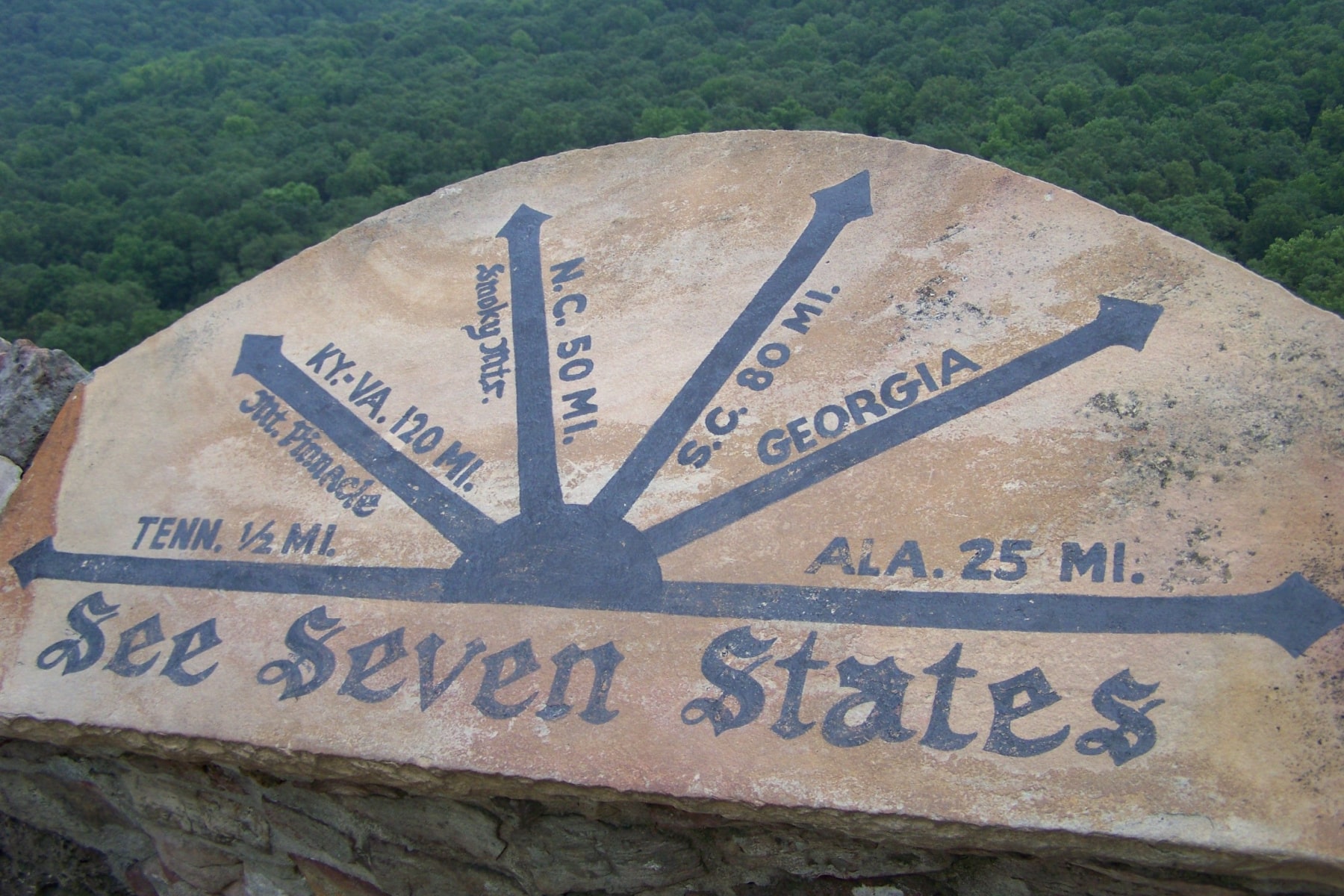
17. Sun Record Company
Our next Tennessee landmark was the first label to record Elvis Presley, Charlie Rich, Roy Orbison, Jerry Lee Lewis, Carl Perkins, and Johnny Cash. At #17 on our list of the Best Tennessee Landmarks is Sun Record Company.
The historic Sun Studio is a recording studio located in Memphis, Tennessee. It was opened by rock pioneer Sam Phillips on January 3, 1950, and originally called Memphis Recording Service.
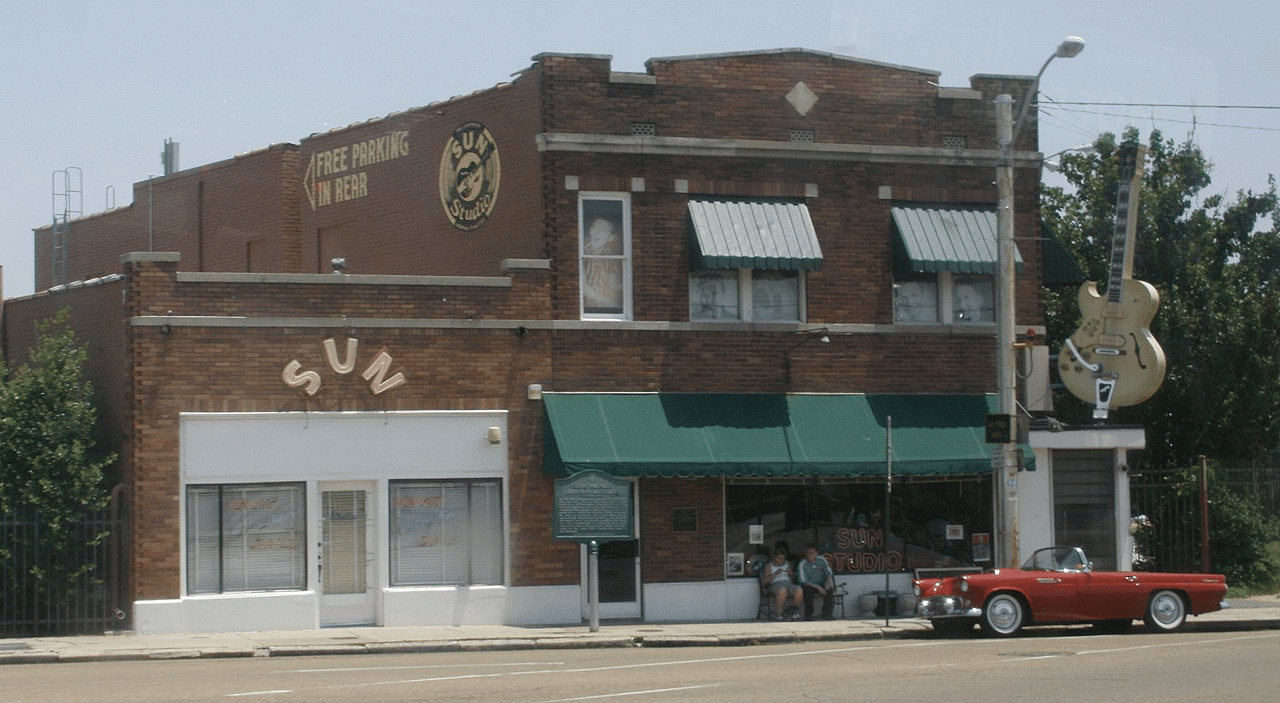
The Birthplace Of Rock & Roll
The studio is known for being the birthplace of rock and roll, as the first rock-and-roll single, Jackie Brenston and his Delta Cats’ “Rocket 88” was recorded there in 1951.
The studio also recorded a variety of blues, R&B and country music artists in the early 1950s, including: Howlin’ Wolf, Junior Parker, B.B. King, James Cotton, Rufus Thomas and Rosco Gordon.
In the latter 1950s, many rock-and-roll, country music, and rockabilly artists, including: Johnny Cash, Elvis Presley, Carl Perkins, Roy Orbison, Charlie Feathers, Jerry Lee Lewis, recorded at the studio for the Sun Records label.
Phillips Recording
In 1959, Sam Phillips opened a larger studio, Phillips Recording, to replace the older facility and in 1969, he sold the label to Shelby Singleton. The building remained inactive until 1985, when the Class of ’55 recording sessions with Carl Perkins, Roy Orbison, Jerry Lee Lewis, and Johnny Cash took place.
The studio was reopened as a tourist attraction in 1987 and has attracted many notable artists including U2, who recorded tracks for Rattle and Hum there.
Sun Studio is a significant landmark in the history of music, particularly rock and roll, and continues to be a popular tourist destination and recording studio today.

16. James K. Polk House
We move from Rock & Roll to presidential history. Tennessee is home to presidents too. At #16 on our list of the Best Tennessee Landmarks is the James K. Polk House.
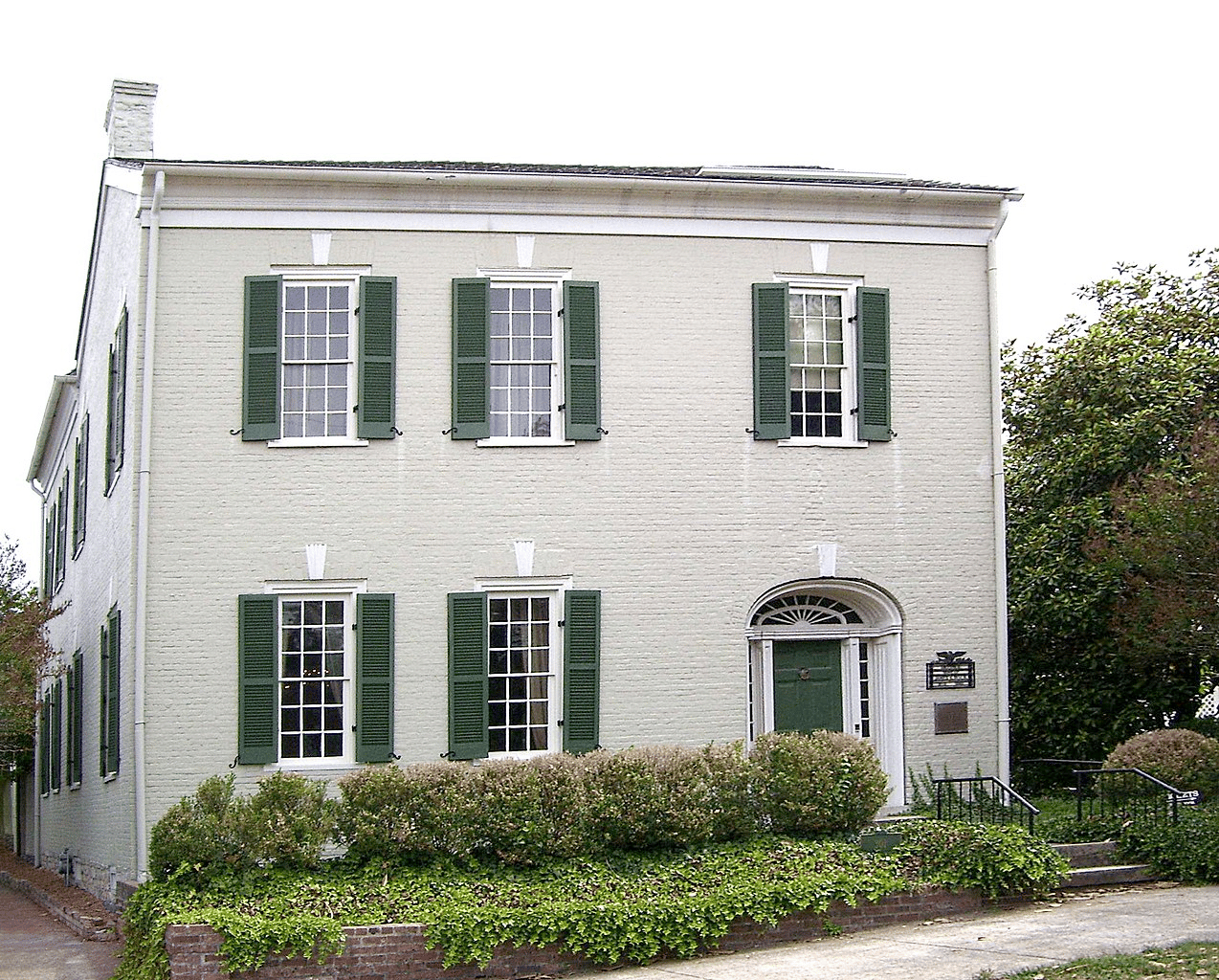
James K. Polk
James K. Polk was the 11th President of the United States, serving from 1845 to 1849. He was born on November 2, 1795, in Mecklenburg County, North Carolina, and grew up in Tennessee. Polk was a lawyer and a politician who served as a member of the U.S. House of Representatives and as governor of Tennessee before becoming president.
During his presidency, Polk achieved several significant accomplishments, including: the annexation of Texas and the negotiation of the Oregon Treaty with Great Britain, which secured the territory of Oregon for the United States.
He also oversaw the establishment of the Treasury Department, the Department of the Interior, and the Naval Academy, and he signed into law the Walker Tariff, which lowered tariffs and encouraged trade.
Polk was a strong believer in Manifest Destiny, the idea that the United States was destined to expand westward, and his policies reflected this belief. His administration was also marked by tensions with Mexico, which ultimately led to the Mexican-American War.
Polk served only one term as president and chose not to run for re-election, as he had accomplished his major goals in office and was in poor health. He died of cholera just a few months after leaving office, on June 15, 1849, at the age of 53.

The James K. Polk House
The James K. Polk House is a historic residence located in Columbia, Tennessee, United States.
It was the only home of James K. Polk and his wife Sarah Childress Polk. The house was built in 1816 and served as the Polks’ primary residence until their move to the White House in 1845.
It’s a two-story brick structure in the Federal style, with a central hallway and four rooms on each floor. The house is now open to the public as a museum and it has been preserved as a National Historic Landmark, allowing visitors to experience the life and times of James K. Polk and his family.
The house contains many of the Polks’ original furnishings and personal items, as well as exhibits about their lives and the political and social issues of the day.

Top 15 Tennessee Landmarks
15. Beale Street Historic District
It’s time to make more beautiful music. At #15 on our list of the Best Historic Sites In Tennessee is Beale Street Historic District.
Beale Street is a street located in Memphis, Tennessee. It is known for its role in the development of blues and jazz music, as well as its association with the city’s African American community.
Beale Street Historic District is a place where you can find the rich history of Memphis music. This district is home to many of the city’s most famous music venues, such as the Orpheum Theatre, the New Daisy Theatre, and the Blues Hall of Fame.
The street is lined with restaurants, bars, and shops, and is a popular destination for both locals and tourists. It also includes the Handy Park, a small park named after W.C Handy, known as the “Father of the Blues.”
The district was listed on the National Register of Historic Places in 1966 and it has been designated as a National Historic Landmark in 1982.
The Beale Street Historic District is now a popular tourist destination, attracting millions of visitors each year who come to experience the street’s vibrant music scene and cultural heritage.

14. The Hermitage
James K. Polk was referred to as “Little Hickory” because he reminded the people of his time of Tennessee’s greatest president who was nicknamed “Old Hickory.” Of course the man whom we’re referring to is Andrew Jackson.
At #14 on our list of the Best Historic Sites In Tennessee is The Hermitage, which was the plantation home of America’s 7th President of the United States.
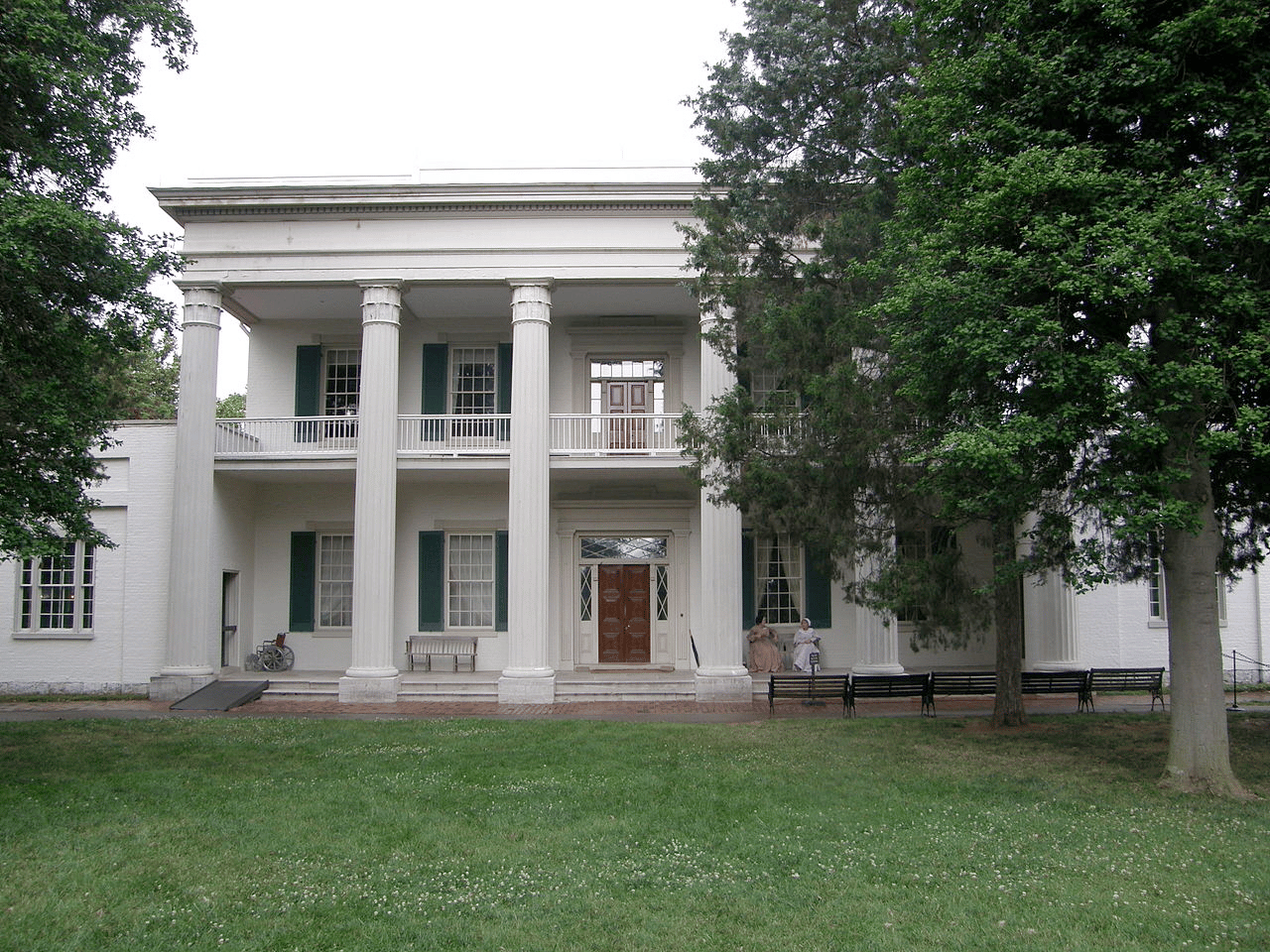
Andrew Jackson
Andrew Jackson served as president from 1829 to 1837. He was born on March 15, 1767, in the Waxhaws region between North Carolina and South Carolina, and grew up in poverty. Jackson was a lawyer, a military leader, and a politician who served as a member of the U.S. House of Representatives and the U.S. Senate.
During his presidency, Jackson was known for his populist policies, which favored the common man over the elite. He vetoed bills that he believed favored special interests, and he dismantled the Second Bank of the United States, which he believed was corrupt and wielded too much power.
Jackson also signed into law the Indian Removal Act, which led to the forced relocation of Native American tribes from their ancestral lands to areas west of the Mississippi River. This policy, known as the Trail of Tears, resulted in the deaths of thousands of Native Americans.
He was also a military hero, having led American forces to victory in the Battle of New Orleans during the War of 1812. He became a symbol of American strength and nationalism, and his reputation as a war hero helped propel him to the presidency.
Despite his popularity, Jackson was a controversial figure, and his presidency was marked by tensions with Congress, clashes with the Supreme Court, and the Nullification Crisis, in which South Carolina threatened to secede from the Union over tariffs.
Things To See At The Hermitage
Some of the things to see at the Hermitage include:
- The mansion: Visitors can tour the historic mansion, which was originally built in the late 18th century and is one of the best-preserved examples of antebellum architecture in the South.
- Exhibits on Andrew Jackson’s life and legacy: Visitors can learn about the life and legacy of Andrew Jackson through exhibits, artifacts, and multimedia displays, including his presidency and his role as a military hero.
- The grounds and gardens: The Hermitage is set on 1,120 acres of lush, rolling farmland, and visitors can explore the gardens and grounds, which include a formal garden, a vegetable garden, and a cemetery.
- The First Hermitage Church: Visitors can tour the First Hermitage Church, a historic building located on the grounds of the Hermitage, which was used by the Jackson family and their slaves for religious services.
- The slave cabin exhibit: Visitors can learn about the lives of the slaves who lived and worked at the Hermitage through a series of exhibits and interactive displays located in the restored slave cabins.

13. Graceland
We move from the home of the President of the United States to the home of the King of Rock & Roll. At #11 on our list of the Best Historic Sites In Tennessee is Graceland, which was the home of Elvis Presley.
Presley was considered to be one of the most influential figures in popular music.
He began his career in the mid-1950s, and his first single, “Heartbreak Hotel,” topped the charts in 1956. He went on to release many hit songs throughout his career, including “Jailhouse Rock,” “Hound Dog,” “Love Me Tender,” “Don’t Be Cruel,” “All Shook Up,” and many others.
Presley also appeared in several films and television shows, and was known for his distinctive voice, energetic performances, and unique style.
He died on August 16, 1977, at the age of 42. Despite his passing, his legacy continues to live on through his music and the many tribute performances and exhibitions.
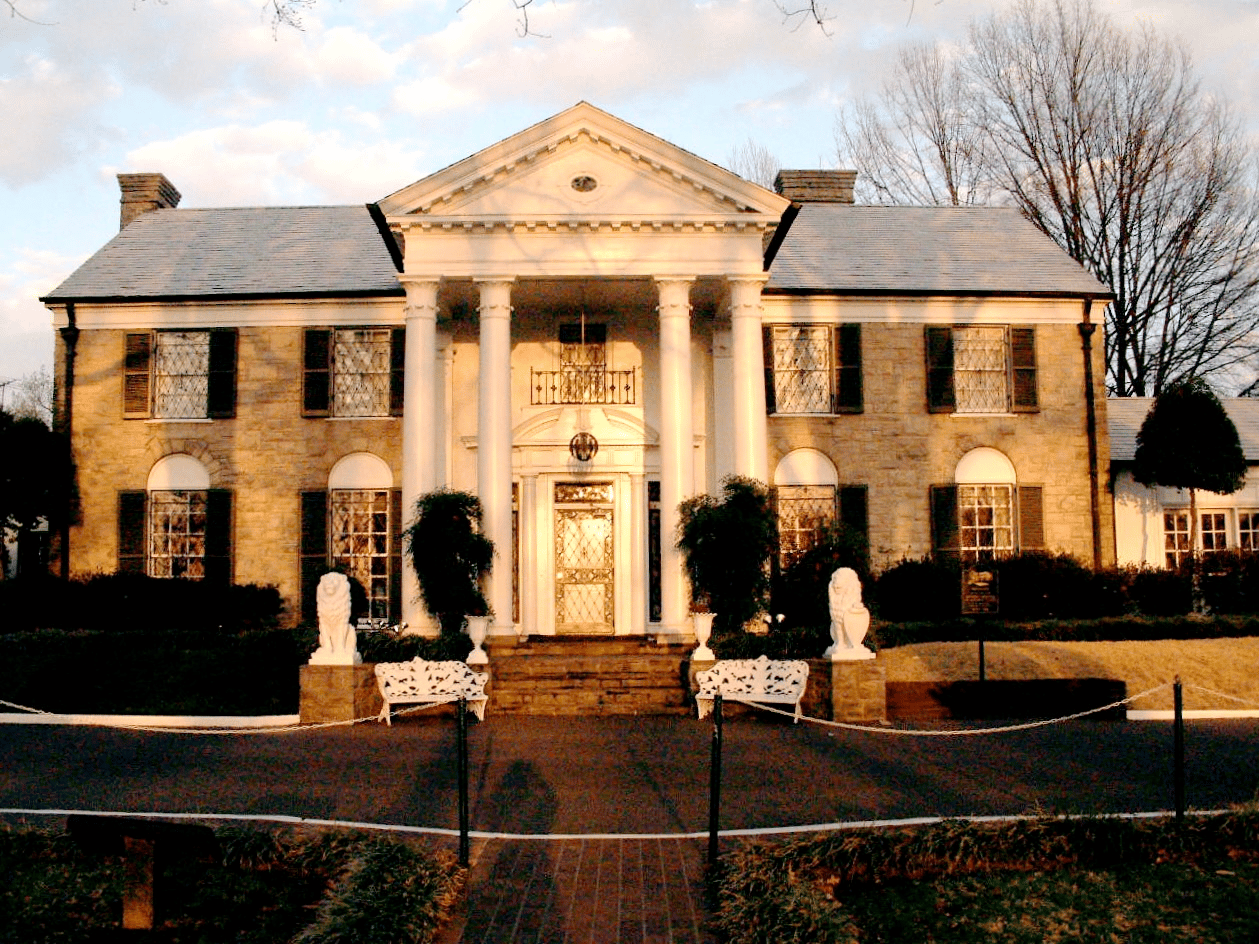
Things To See At Graceland
- The mansion, including Presley’s personal quarters and decor
- The Trophy Building with Presley’s awards, gold records and jumpsuits
- The Racquetball Building with Presley’s private jets
- The Meditation Garden with Presley’s grave and family members’ graves
- The Elvis Presley Automobile Museum with Presley’s cars
- Various exhibits and displays showcasing Presley’s life and career.

12. Andrew Johnson National Historic Site
Tennessee is home to presidents and our next landmark examines the legacy of yet another President of the United States. Welcome to the Andrew Johnson National Historic Site.
Andrew Johnson was born in Raleigh, North Carolina, in 1808 and moved to Greeneville, Tennessee, as a young man. He served as the mayor of Greeneville, a member of the Tennessee state legislature, and a congressman before being elected as Vice President under Abraham Lincoln in 1864.
Following Lincoln’s assassination in 1865, Johnson became President and was tasked with overseeing the Reconstruction of the South after the Civil War.
Johnson’s Reconstruction policies were controversial and were met with opposition from both Northern Republicans and Southern Democrats.

Johnson’s Presidency Was Marked By Conflict & Turmoil
Despite his efforts to restore the Union and promote racial equality, Johnson’s presidency was marked by conflict and turmoil. He was impeached by the House of Representatives in 1868, but narrowly avoided conviction and removal from office after a trial in the Senate.
Following his presidency, Johnson returned to Greeneville and lived out the rest of his life there. Today, the Andrew Johnson National Historic Site includes several historic buildings, including Johnson’s family home, his tailor shop, and the Andrew Johnson National Cemetery, where he and his family members are buried.
The site offers guided tours, exhibits, and educational programs that explore the life and legacy of Andrew Johnson, his presidency, and the tumultuous era in which he lived.
The Andrew Johnson National Historic Site is an important cultural and historical landmark that offers insight into the complex and often contentious history of the United States during the Reconstruction era.
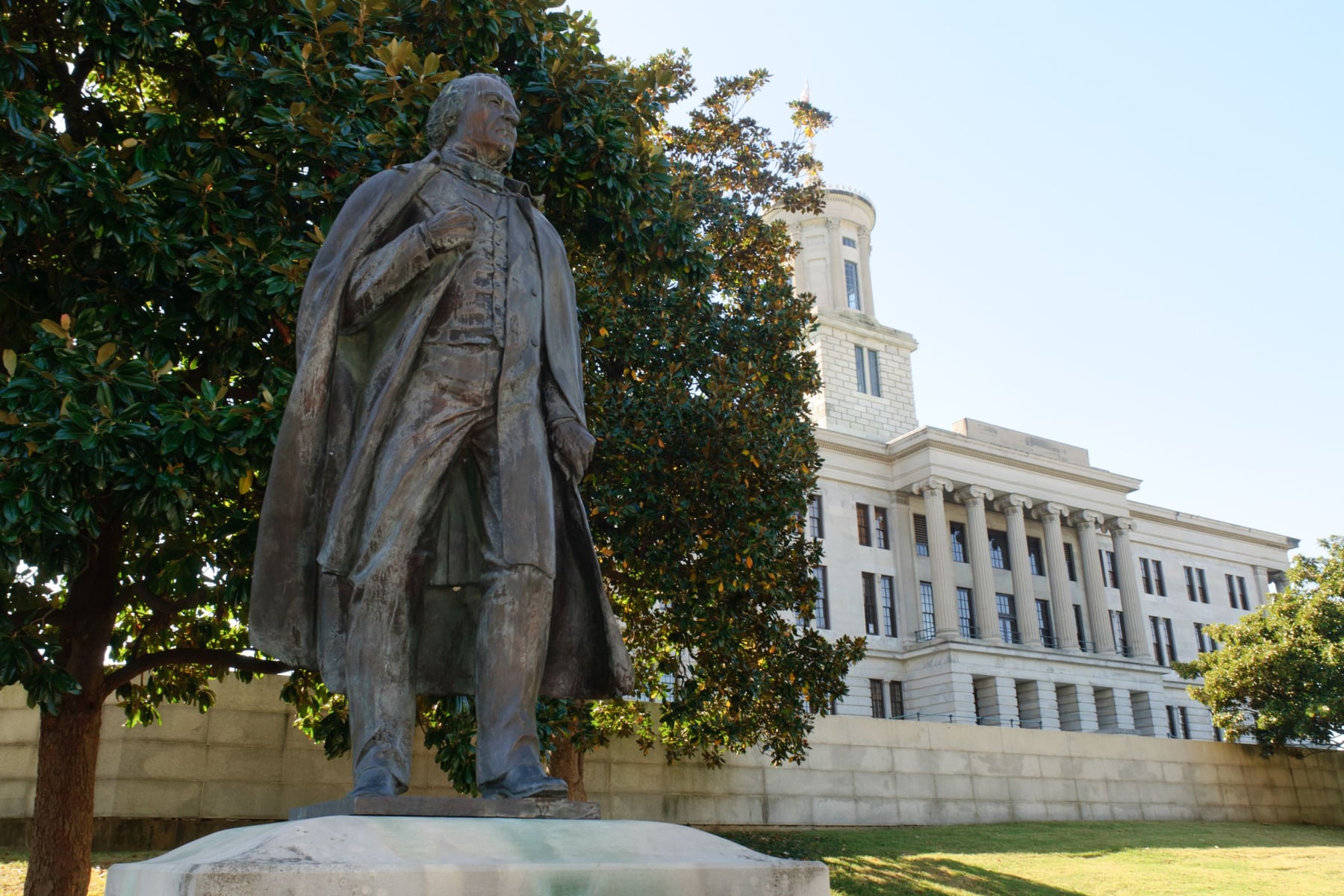
11. Stones River National Battlefield
America’s bloodiest conflict was the Civil War and there are some excellent historic sites in Tennessee. Our next site is one of them. At #11 on our list of the Best Tennessee Landmarks is Stones River National Battlefield.
The Stones River National Battlefield is located in Murfreesboro, Tennessee. It commemorates the Battle of Stones River, one of the bloodiest and most significant battles of the American Civil War.
The Battle of Stones River took place from December 31, 1862, to January 2, 1863, and was fought between Union forces commanded by Major General William S. Rosecrans and Confederate forces commanded by General Braxton Bragg.
The battle was fought in and around Murfreesboro and resulted in heavy casualties on both sides, with approximately 23,000 total casualties.
Despite suffering heavy losses, the Union forces were able to secure a strategic victory at Stones River. The battle helped cement Union control of Middle Tennessee and set the stage for later Union victories in the region.
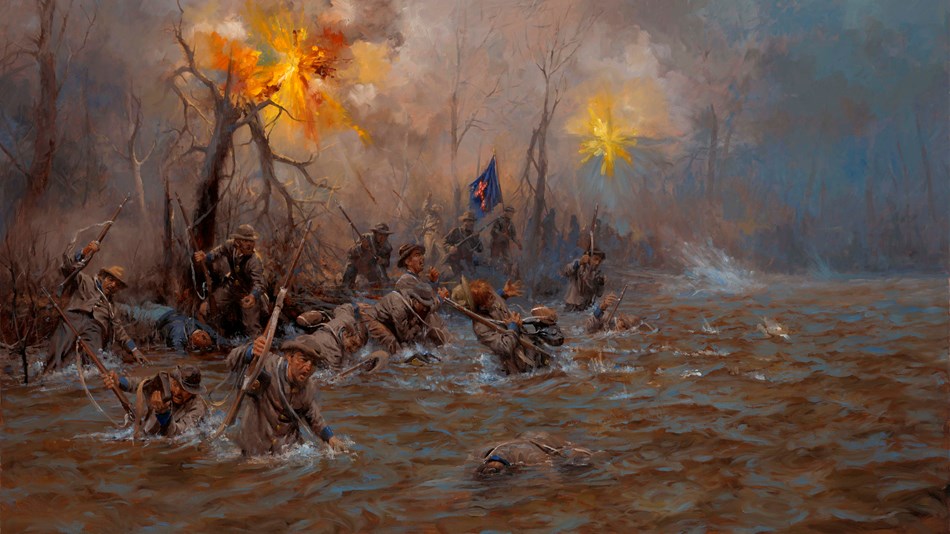
Things To Do
- Explore the battlefield: Take a self-guided tour of the battlefield to see where the Union and Confederate forces clashed during the battle. There are several interpretive markers and exhibits that provide information about the battle and the soldiers who fought there.
- Visit the museum: The museum at Stones River National Battlefield features exhibits on the battle, including artifacts, photographs, and interactive displays. The museum also has a bookstore where you can purchase books, maps, and other souvenirs.
- Hike or bike the trails: The park has several hiking and biking trails that wind through the battlefield and surrounding woodlands. The 2-mile paved trail is wheelchair accessible, while the 6-mile Battlefield Trail offers a more rugged experience.
- Picnic: Bring a picnic lunch and enjoy one of the park’s picnic areas, which offer scenic views of the battlefield and surrounding countryside.
- Visit the cemetery: The Stones River National Cemetery is located adjacent to the park and contains the graves of Union soldiers who died during the battle. It is a somber reminder of the human cost of the Civil War.
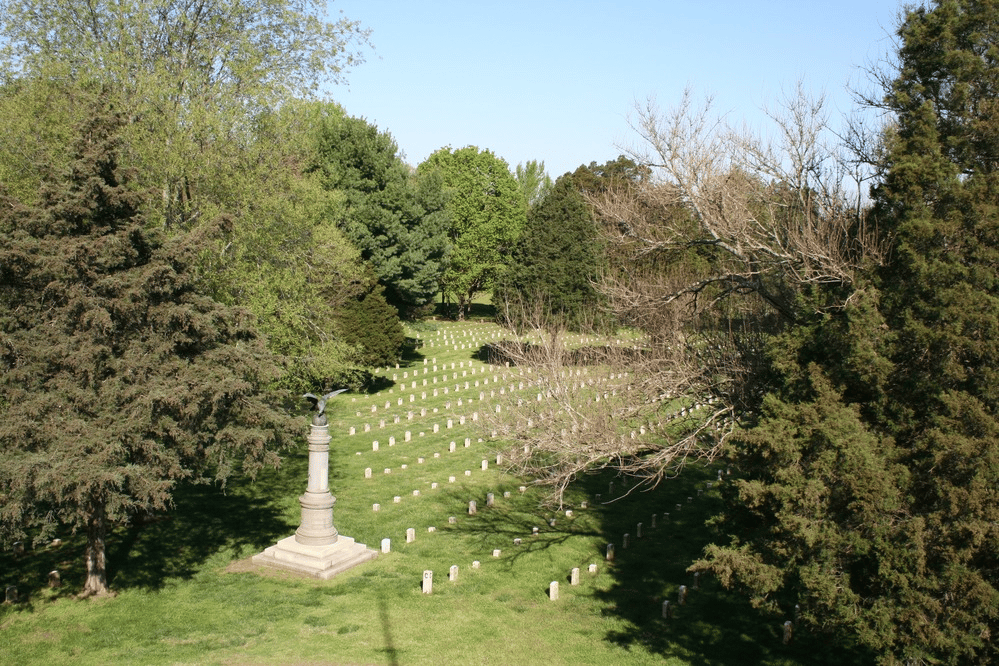
CHECK OUT: 10 BEST Civil War Sites In America
Top 10 Tennessee Landmarks
10. National Civil Rights Museum
Our next Tennessee landmark has a robust collection of historic objects, documents and images shares not only the American Civil Rights Movement but also the culture of slavery, African-American history and international human rights.
At #10 on our list of the Best Tennessee Landmarks is the National Civil Rights Museum.

National Civil Rights Museum | Courtesy of Wikimedia Commons
Historical Significance
The National Civil Rights Museum is dedicated to chronicling the history of the American Civil Rights Movement and its impact on the struggle for equality and justice. It offers visitors a comprehensive and immersive experience that spans from the era of slavery to the present day.
The museum is located at 450 Mulberry Street in Memphis, Tennessee. The main building is the former Lorraine Motel, a two-story structure that was converted into a civil rights museum in 1991. The building’s exterior and layout have been preserved to reflect its appearance at the time of Dr. Martin Luther King’s assassination.
The museum’s exhibits feature a vast collection of artifacts, interactive displays, and multimedia presentations that depict key events and individuals in the civil rights movement. Exhibits explore topics such as slavery, the Jim Crow era, the Montgomery Bus Boycott, the Freedom Rides, and the March on Washington, among others.
One of the most significant areas of the museum is Room 306, which is the actual room where Dr. Martin Luther King Jr. stayed in the Lorraine Motel. The room has been preserved and recreated to provide visitors with a glimpse into the last moments of Dr. King’s life.

Civil Rights Movement Highlights
In addition to the Lorraine Motel, the museum includes the Legacy Building, which houses additional exhibits, theaters, educational spaces, and a large gallery dedicated to the ongoing struggle for civil rights. It also features temporary exhibits that explore contemporary civil rights issues.
The museum highlights significant events and figures of the civil rights movement, including Rosa Parks, the Selma to Montgomery March, the Birmingham Campaign, the Student Nonviolent Coordinating Committee (SNCC), and the Southern Christian Leadership Conference (SCLC), among others.
The National Civil Rights Museum not only focuses on the history of the civil rights movement but also addresses its ongoing impact and the ongoing struggle for civil rights and social justice. It encourages visitors to reflect on the progress made and the challenges that still exist today.
The museum offers educational programs for students and teachers, including guided tours, workshops, and lectures. It also hosts a range of events, such as panel discussions, film screenings, and performances, to engage the public in dialogue and further the conversation on civil rights.

9. Natchez Trace Parkway
Our next Tennessee landmark is a “Drive through 10,000 Years of History.” At #9 on our list of the Best Tennessee Landmarks is the Natchez Trace Parkway.
The Natchez Trace Parkway is a 444-mile recreational road and scenic drive through three states. It roughly follows the “Old Natchez Trace” a historic travel corridor used by American Indians, “Kaintucks,” European settlers, slave traders, soldiers, and future presidents.
It’s a path that was used by American Indians, European settlers, and traders for thousands of years. The parkway is operated by the National Park Service and provides visitors with the opportunity to experience the natural beauty and cultural history of the region.
The parkway offers a variety of recreational opportunities, including hiking, biking, horseback riding, and picnicking.
There are also several campgrounds and picnic areas located along the route. Along the way, visitors can also experience the beauty of the southern landscape, including hardwood forests, wetlands, and prairies, as well as a wide variety of wildlife.
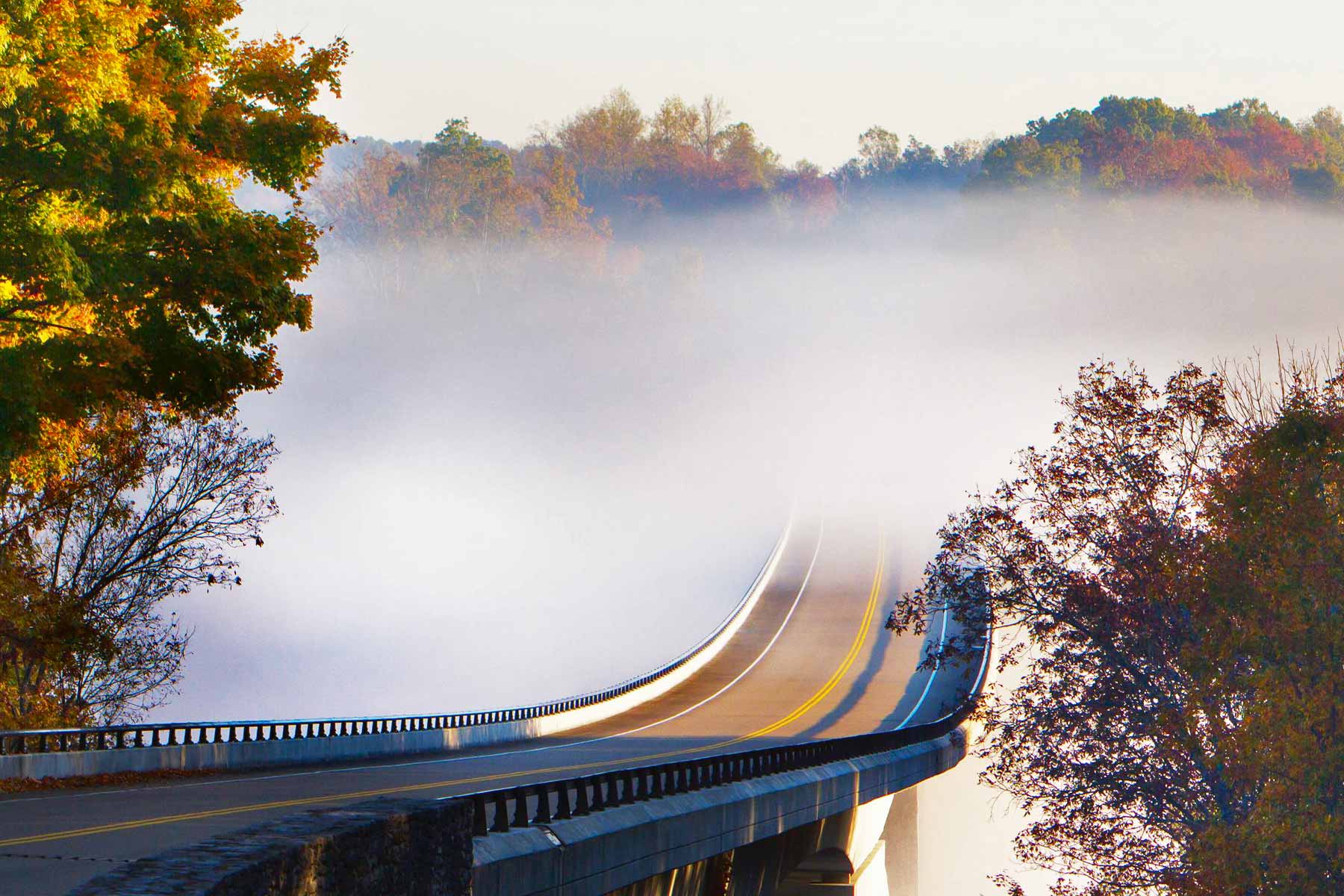
The Parkway Features Several Historic Sites
The parkway also features several historic sites, such as the Sunken Trace, a section of the original trail that has been preserved and is visible from the parkway; the Meriwether Lewis Monument, which marks the spot where the explorer died; and the Emerald Mound, which is the second largest ceremonial mound in the United States.
The Natchez Trace Parkway also offers visitors a chance to explore the rich cultural heritage of the region, including the history of the Natchez and Chickasaw tribes, the American Revolutionary War, and the Civil War.
The parkway also provides a variety of interpretive programs and guided tours to help visitors learn more about the history and culture of the region.
8. Cumberland Gap National Historical Park
Tennessee is a land of natural wonders. Our next landmark commemorates a natural pass through the Appalachian Mountains that has played an important role in American history.
At #8 we have the Cumberland Gap National Historical Park.
The Cumberland Gap National Historical Park is located on the border of Kentucky, Tennessee, and Virginia.
It was first used by Native Americans as a trade route and later by early European settlers who used it to expand westward.
During the American Revolution, the Cumberland Gap was a strategic point of contention between British and American forces.
In the years following the Revolution, the Cumberland Gap continued to play a key role in westward expansion and the opening of new territories for settlement.
In 1940, the Cumberland Gap National Historical Park was established to preserve and commemorate the history of the area. The park encompasses over 24,000 acres and includes several historic buildings, hiking trails, and scenic overlooks.
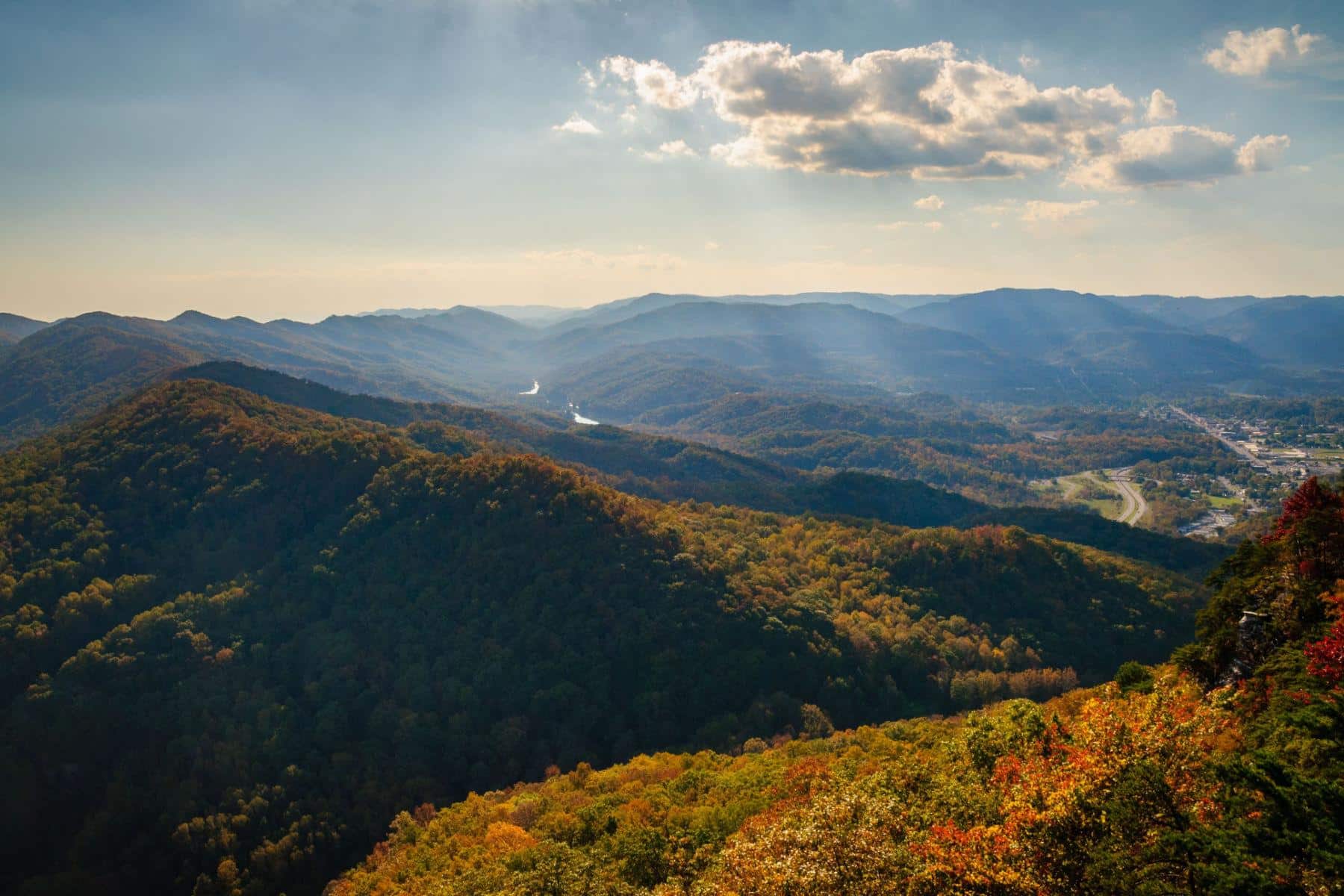
The Cumberland Gap Today
The park offers a range of educational programs, exhibits, and guided tours that explore the history and significance of the Cumberland Gap and its role in American history.
Visitors to the park can explore the Gap Cave, which features a variety of underground formations and an underground river, or hike to the Pinnacle Overlook for stunning views of the surrounding mountains and valleys.
The Cumberland Gap National Historical Park is an important cultural and historical landmark that offers insight into the history of westward expansion and the role that natural landmarks like the Cumberland Gap played in shaping American history.
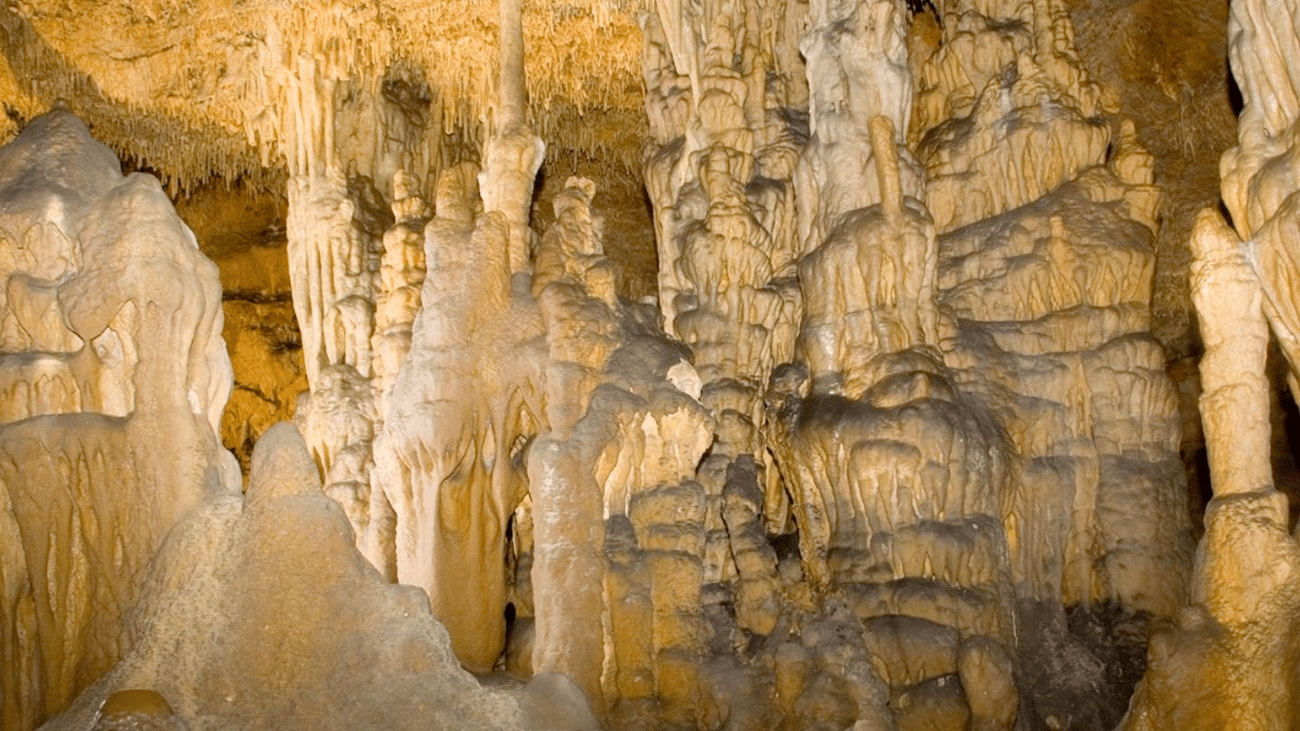
7. Trail Of Tears National Historic Trail
Our next landmark is a different type of path. It commemorates a tragic chapter in American history – the removal of the Cherokee and the paths that 17 Cherokee detachments followed westward.
At #7 on our list of the Best Tennessee Landmarks is the Trail Of Tears National Historic Trail.
The Trail of Tears National Historic Trail commemorates the forced removal of the Cherokee Nation from their ancestral lands in the southeastern United States to Indian Territory in present-day Oklahoma in 1838-1839.
This event is known as the Trail of Tears, and it resulted in the deaths of thousands of Cherokee people.

Andrew Jackson & The Indian Removal Act
In the 1830s, the US government passed the Indian Removal Act, which authorized the forced removal of Native American tribes from their ancestral lands to make way for white settlement.
Despite legal challenges and protests from the Cherokee Nation, President Andrew Jackson ordered the Cherokee to be forcibly removed from their lands in Georgia, North Carolina, Tennessee, and Alabama and relocated to Indian Territory in present-day Oklahoma.
The Cherokee were forced to travel over 800 miles on foot, with little food, water, or shelter, in what became known as the Trail of Tears. Many Cherokee people died from exposure, disease, and starvation during the journey, and the Trail of Tears remains a traumatic and tragic event in Cherokee history.
The Trail Of Tears Today
The Trail of Tears National Historic Trail was established in 1987 to commemorate the history and legacy of the Cherokee Nation and the Trail of Tears.
The trail stretches over 5,000 miles through nine states, following the routes taken by several Native American tribes during their forced removal to Indian Territory.
Today, the Trail of Tears National Historic Trail offers a range of exhibits, educational programs, and interpretive centers that explore the history and legacy of the Trail of Tears and its impact on Native American communities.

6. Manhattan Project National Historical Park
Our next site was part of a massive government project which helped to end a war and, in the process, changed the world. At #6 on our list of the Best Tennessee Landmarks is the Manhattan Project National Historical Park.

The Manhattan Project
The Manhattan Project was a research and development project during World War II that produced the first nuclear weapons. It was named after the Manhattan Engineer District of the U.S. Army Corps of Engineers, which managed the project.
It was launched in 1939, after a group of scientists, including Albert Einstein, warned the US government that Nazi Germany might be developing nuclear weapons. The project was focused on developing two types of nuclear weapons: the atomic bomb, which was based on fission, and the hydrogen bomb, which was based on fusion.
It also involved many of the world’s leading scientists and engineers, including Robert Oppenheimer, Enrico Fermi, and Leo Szilard. It was conducted in top-secret facilities across the United States, including Los Alamos, New Mexico; Oak Ridge, Tennessee; and Hanford, Washington.
The Manhattan Project ultimately led to the successful testing of the first atomic bomb on July 16, 1945, at the Trinity site in New Mexico. The atomic bombs developed during the project were subsequently used by the United States to end World War II by dropping them on the Japanese cities of Hiroshima and Nagasaki in August 1945.

Oak Ridge, Tennessee
Oak Ridge, Tennessee was selected as one of the main sites for the project because of its location in the rolling hills and narrow valleys of East Tennessee. The city was not on any maps and was known as the “Secret City”.
Oak Ridge played a crucial role in the Manhattan Project and was the location of several massive facilities that employed thousands of workers. These facilities were focused on enriching uranium for use in the atomic bomb. The city was also the headquarters for the project after it was relocated from New York City.
After the war, Oak Ridge continued to play a significant role in the development of nuclear technology and energy. Today, Oak Ridge is home to several museums that commemorate the city’s history and the role it played in the Manhattan Project.
Visitors can visit the American Museum of Science and Energy, the K-25 History Museum, The Oak Ridge History Museum, and the Oak Ridge Children’s Museum. These museums offer a unique glimpse into the history of Oak Ridge, the Manhattan Project, and the development of atomic energy.

CHECK OUT: 25 Bucket List Famous Landmarks In America (MUST-SEE)
Top 5 Tennessee Landmarks
5. Fort Donelson National Battlefield
We’re on to our Top 5 Tennessee Landmarks. And Tennessee is home to some of the most important Civil War sites in America. Our next landmark is a case in point. At #5 on our list of the Best Tennessee Landmarks is Fort Donelson National Battlefield.
Fort Donelson National Battlefield is located in Dover, Tennessee. It commemorates the Battle of Fort Donelson, a significant engagement during the American Civil War.
The Battle of Fort Donelson took place from February 11 to 16, 1862, and was fought between Union forces commanded by Brigadier General Ulysses S. Grant and Confederate forces commanded by Brigadier General John B. Floyd and Brigadier General Gideon J. Pillow.
The battle resulted in a decisive Union victory, with over 12,000 Confederate soldiers surrendering to Grant’s forces.
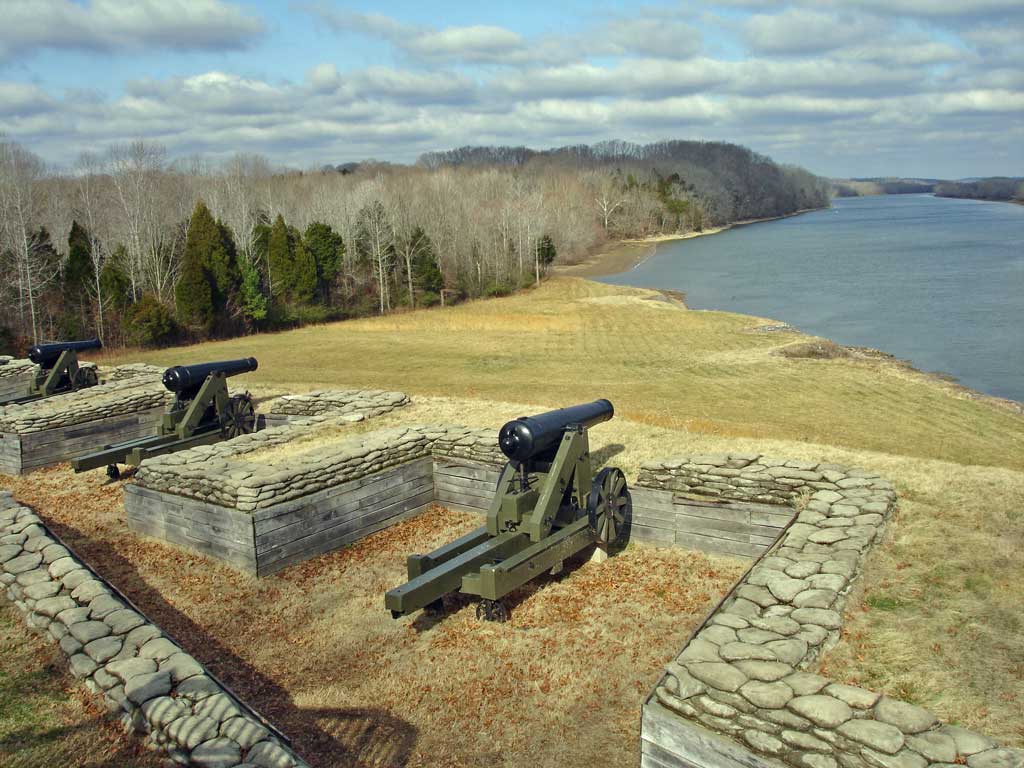
The Victory Launched The Career Of Ulysses S. Grant
The victory at Fort Donelson was a major turning point in the Civil War, as it helped secure Union control of the Mississippi River and opened up new opportunities for Union forces to push deeper into the Confederate heartland.
The battle also earned Grant national recognition and helped to establish him as one of the most important Union commanders of the war.
After the war, the site of the battle was preserved as a national park and was designated as a national battlefield in 1928.
Today, Fort Donelson National Battlefield is a popular destination for history enthusiasts and offers a range of exhibits, guided tours, and educational programs that explore the history and significance of the battle and its impact on the course of the Civil War.
The park includes several historic buildings and landmarks, including the Fort Donelson National Cemetery, which is the final resting place of over 500 Union soldiers who died during the battle.
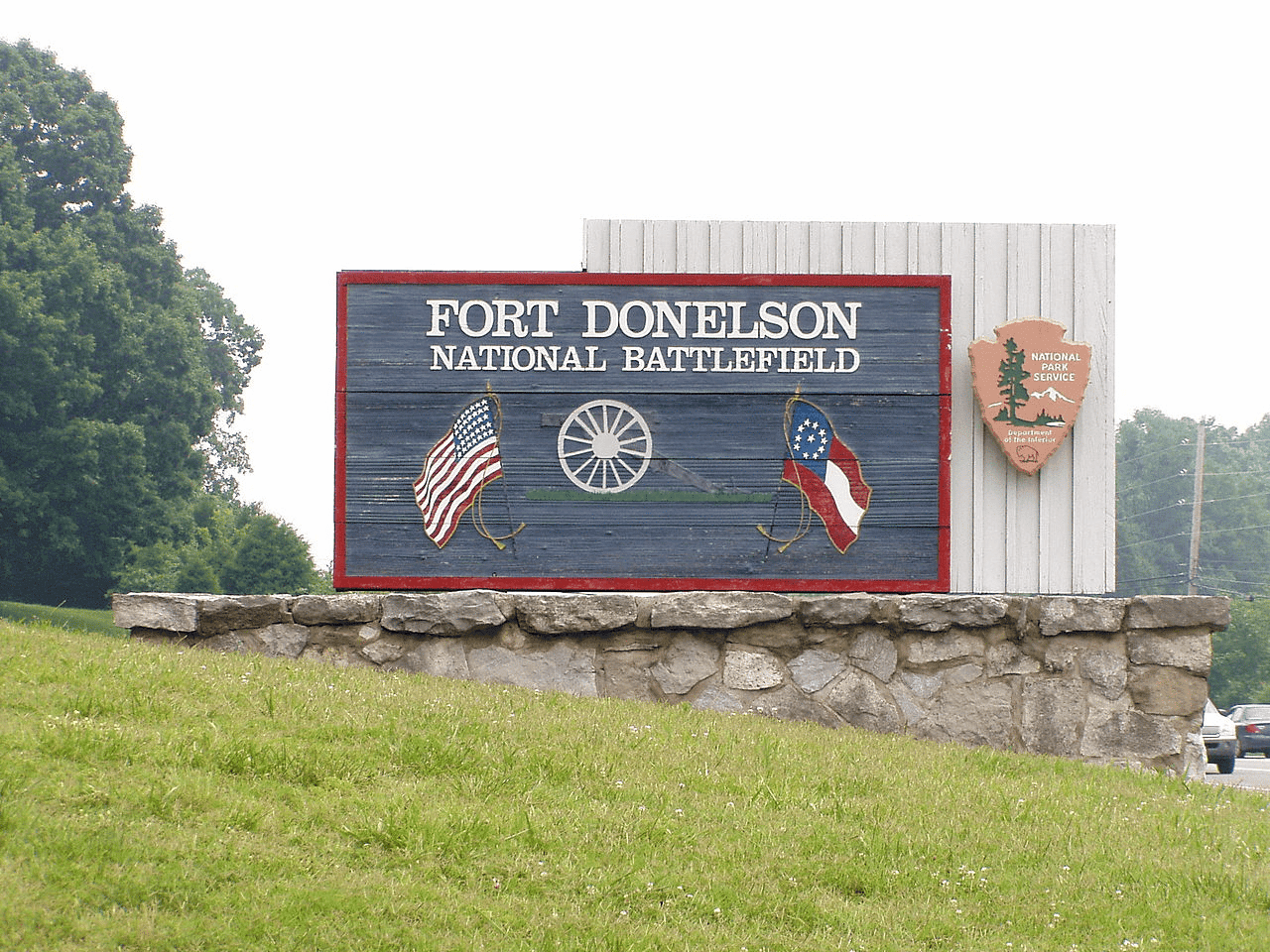
CHECK OUT: 10 BEST Civil War Sites In America
4. Grand Ole Opry
Next up is a place that is dedicated to honoring country music and its history. It showcases a mix of famous singers and contemporary chart-toppers performing country, bluegrass, Americana, folk, and gospel music as well as comedic performances and skits.
At #4 on our list of the Best Tennessee Landmarks is the Grand Ole Opry.

Grand Ole Opry photo from a 1944 advertisement | Courtesy of Wikimedia Commons
A Short History
On November 28, 1925, the WSM Barn Dance radio show debuted on Nashville’s WSM radio station. It was originally conceived as a one-hour program featuring old-time fiddle tunes and traditional folk music.
In 1927, the show’s name was changed to the Grand Ole Opry, a nod to the grand opera featured at the time. The name stuck, and the program began to attract a wider audience.
As the popularity of the Grand Ole Opry grew, it became synonymous with Nashville and country music. It showcased various genres, including hillbilly, Western swing, and bluegrass, and introduced a wide array of talented musicians and performers.

Portrait of Shorty Warren, Rosalie Allen, Ernest Tubb, Cy Sweat, Dave Miller, Radio Dot, Smokey Warren, Dick Richards, Minnie Pearl, Bob McCoy, and Smokey Swan | Courtesy of Wikimedia Commons
A New Home
n 1943, the Grand Ole Opry moved to the Ryman Auditorium, a former church building known for its exceptional acoustics. The Opry’s tenure at the Ryman lasted for more than three decades, solidifying the venue’s status as the “Mother Church of Country Music.”
The Grand Ole Opry’s radio broadcasts expanded nationwide during the 1930s and 1940s, gaining a significant following. It played a crucial role in popularizing country music and launching the careers of numerous artists, including Roy Acuff, Minnie Pearl, and Bill Monroe.
With the increasing popularity of television in the 1950s, the Grand Ole Opry evolved from primarily a radio show to a live stage performance. This transition allowed fans to experience the Opry firsthand, resulting in sold-out shows and an even larger fan base.
In 1974, the Grand Ole Opry relocated to a larger, purpose-built venue called the Grand Ole Opry House, located in Nashville’s suburb of Opryland. The new venue provided state-of-the-art facilities, including modern sound systems and seating for thousands of spectators.

Grand Ole Opry | Courtesy of Wikimedia Commons
The Grand Ole Opry In The 21st Century
In May 2010, the Cumberland River flooded, causing significant damage to the Grand Ole Opry House and forcing its closure for repairs. However, the Opry spirit persevered, and performances were temporarily moved to other Nashville venues until the Opry House reopened in September 2010.
Over the years, the Grand Ole Opry has remained a pinnacle of country music and an influential institution within the industry. It has hosted countless legendary performers, including Johnny Cash, Dolly Parton, Garth Brooks, and many others, while continuing to introduce emerging talents.
Today the Grand Ole Opry continues to thrive as a live stage show, showcasing the best of country, bluegrass, and Americana music. It maintains a diverse lineup of artists and remains an essential part of Nashville’s cultural landscape.
3. Overmountain Victory National Historic Trail
The American Civil War is not only conflict celebrated in Tennessee. Our next landmark honors an even older conflict. It was the war that brought the United States of America into being.
At #3 on our list of the Best Tennessee Landmarks is the Overmountain Victory National Historic Trail.
The Overmountain Victory National Historic Trail is a commemorative trail that follows the routes taken by patriot militia during the American Revolutionary War.
The trail stretches from the present-day states of Virginia, North Carolina, Tennessee, and South Carolina. The trail commemorates the journey of the Overmountain Men, a group of patriot militia who marched over the Appalachian Mountains to engage in the Battle of Kings Mountain.
The Battle of Kings Mountain was fought on October 7, 1780, between the patriot militia and a detachment of the British army led by Major Patrick Ferguson.
The battle was a turning point in the southern campaign of the Revolutionary War, as the Patriots were able to defeat a larger and better-trained British force. The Overmountain Men played a crucial role in the victory, as their surprise attack on the British flank turned the tide of the battle.
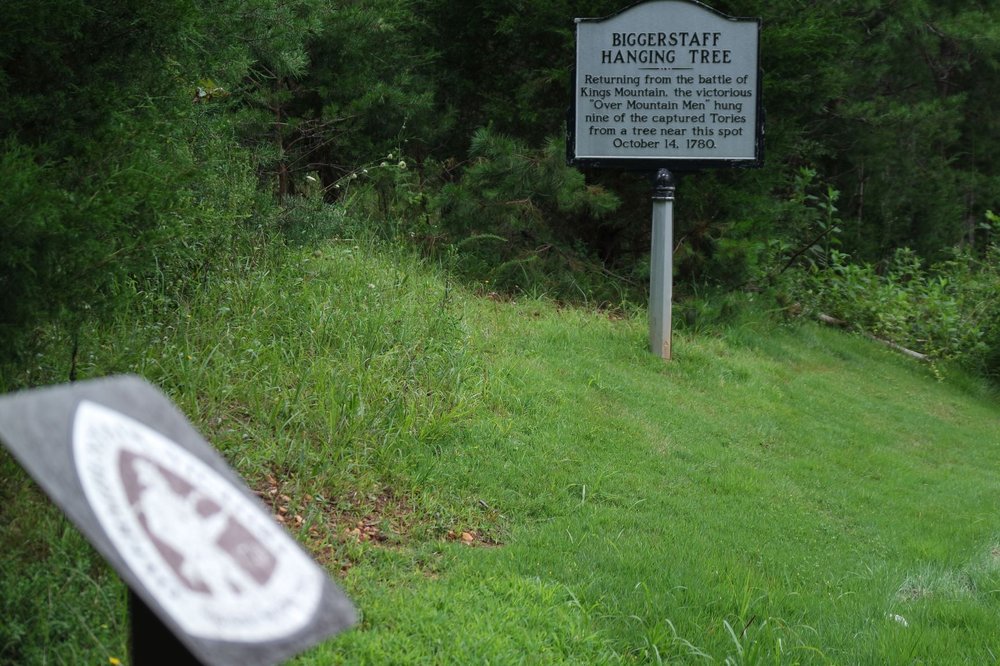
The Trail Was Established In 1980
The trail was established in 1980 and it is approximately 330 miles long. It is a multi-use trail, open to hikers, horseback riders, and bicyclists, and includes a variety of historical and cultural sites, such as museums, visitor centers, and historic homes, which help visitors to understand the history of the trail and the Battle of Kings Mountain.
The Overmountain Victory National Historic Trail is part of the National Trails System, and it is administered by the National Park Service.
The trail is open to the public, and visitors can follow the trail by using a detailed brochure and map, which is available at various visitor centers and park offices.
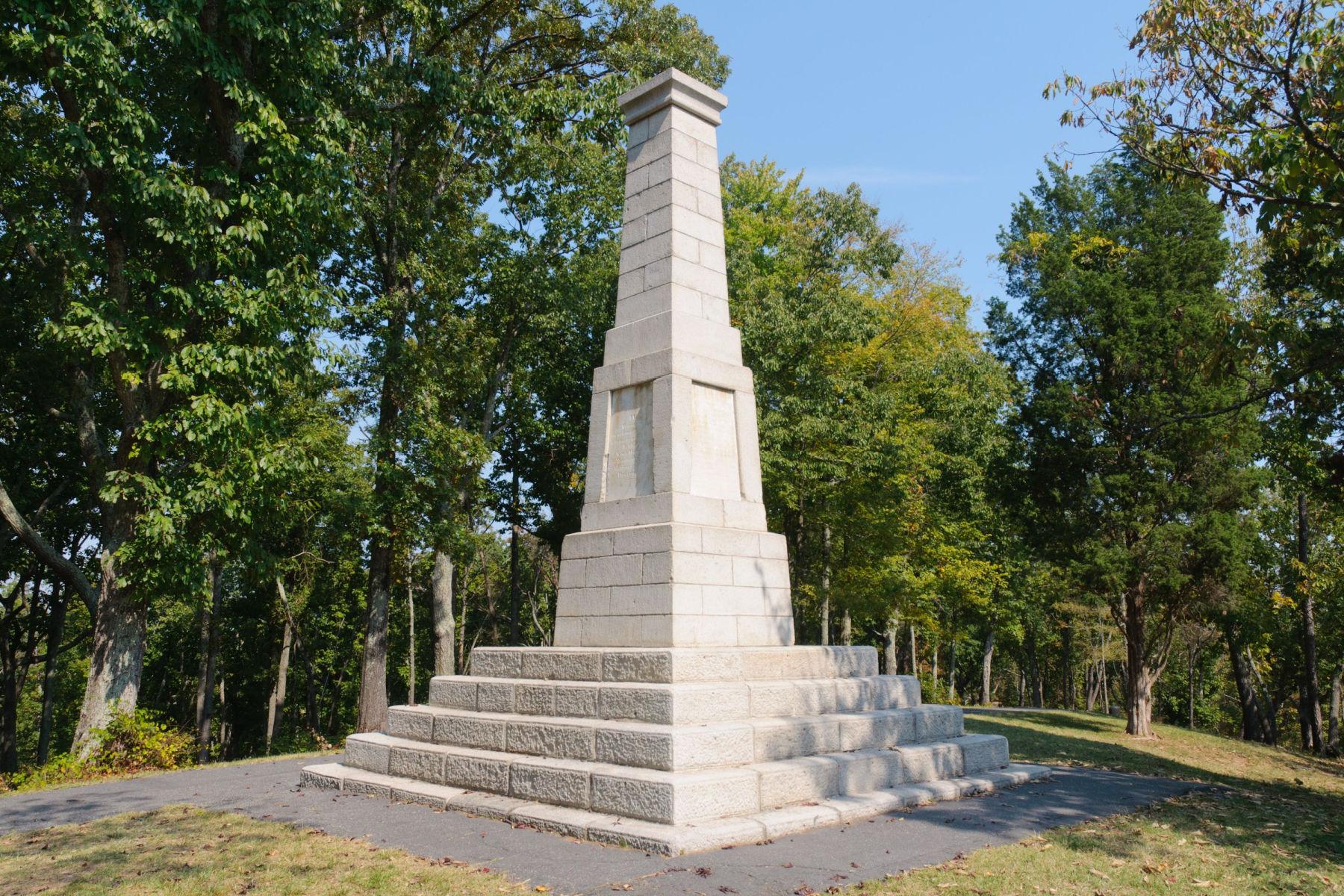
CHECK OUT: 10 BEST Revolutionary War Sites In America
2. Chickamauga & Chattanooga National Military Park
We’re on to the final two landmarks. In the runner-up spot at #2 is a site which is really 2-sites-in-1. At #2 on our list of the Best Tennessee Landmarks is Chickamauga & Chattanooga National Military Park.
Chickamauga and Chattanooga National Military Park is a U.S. National Military Park located in Georgia and Tennessee that commemorates the two major battles fought in the area during the American Civil War: the Battle of Chickamauga and the Battle of Chattanooga.
The Battle of Chickamauga was fought on September 19-20, 1863, and it was one of the largest battles fought in the western theater of the Civil War.
The Confederate army, led by General Braxton Bragg, defeated the Union army, led by General William Rosecrans, and forced them to retreat to Chattanooga. This battle was the most significant Confederate victory in the western theater and opened the door for the Confederate army to move into Tennessee.
The Battle of Chattanooga was fought on November 23-25, 1863. Union forces, led by General Ulysses S. Grant, successfully drove the Confederate army out of Chattanooga, breaking the Confederate hold on the city and opening the door for the Union army to invade Georgia.
Things To Do
- Visit the Chickamauga Battlefield Visitor Center – The Chickamauga Battlefield Visitor Center is the starting point for exploring the park. The center provides a range of exhibits and displays that detail the history of the battles fought in the area.
- Take a ranger-led tour – The park offers a variety of ranger-led tours, including battlefield hikes and driving tours. These tours provide a more in-depth look at the battles fought in the area and the park’s history.
- Explore the trails – The park has over 40 miles of trails that wind through the Chickamauga Battlefield and Lookout Mountain. These trails offer scenic views of the park and the surrounding area.
- Visit Point Park – Point Park is located on Lookout Mountain and offers a panoramic view of the surrounding area. The park is also home to the New York Peace Memorial, which commemorates the Battle of Lookout Mountain.
- Tour the Cravens House – The Cravens House is a historic home that served as a headquarters during the Battle of Lookout Mountain. The home has been restored and now serves as a museum.
- Visit the National Cemetery – The Chattanooga National Cemetery is the final resting place for over 12,000 Union soldiers. The cemetery is a peaceful and somber reminder of the cost of the Civil War.
- Drive the Lookout Mountain Scenic Highway – The Lookout Mountain Scenic Highway is a 10-mile drive that winds through the park and offers stunning views of the surrounding area.
- Go on a picnic – The park has several picnic areas where visitors can enjoy a meal while taking in the beautiful scenery.

1. Shiloh National Military Park
As the #1 Tennessee landmark, More Than Just Parks has selected one of the best preserved and most important Civil War battlefields in the United States. Welcome to Shiloh National Military Park.
The Battle of Shiloh was a major engagement of the American Civil War fought on April 6-7, 1862, in southwestern Tennessee. The Union army, led by General Ulysses S. Grant, faced off against the Confederate army, commanded by General Albert Sidney Johnston and General P.G.T. Beauregard.
On the first day of the battle, the Confederate forces launched a surprise attack on the Union troops, catching them off guard and pushing them back. However, the Union soldiers held their ground and fought fiercely, and reinforcements arrived overnight, bolstering their position.
On the second day, the Union army counterattacked and regained the ground they had lost the day before. The Confederate forces, outnumbered and running low on supplies, were forced to retreat.
The battle was one of the bloodiest of the Civil War, with a combined total of over 23,000 casualties.
The Union army suffered approximately 13,000 casualties, while the Confederate army suffered approximately 10,000. General Johnston was killed in action, becoming the highest-ranking general to die in the war.
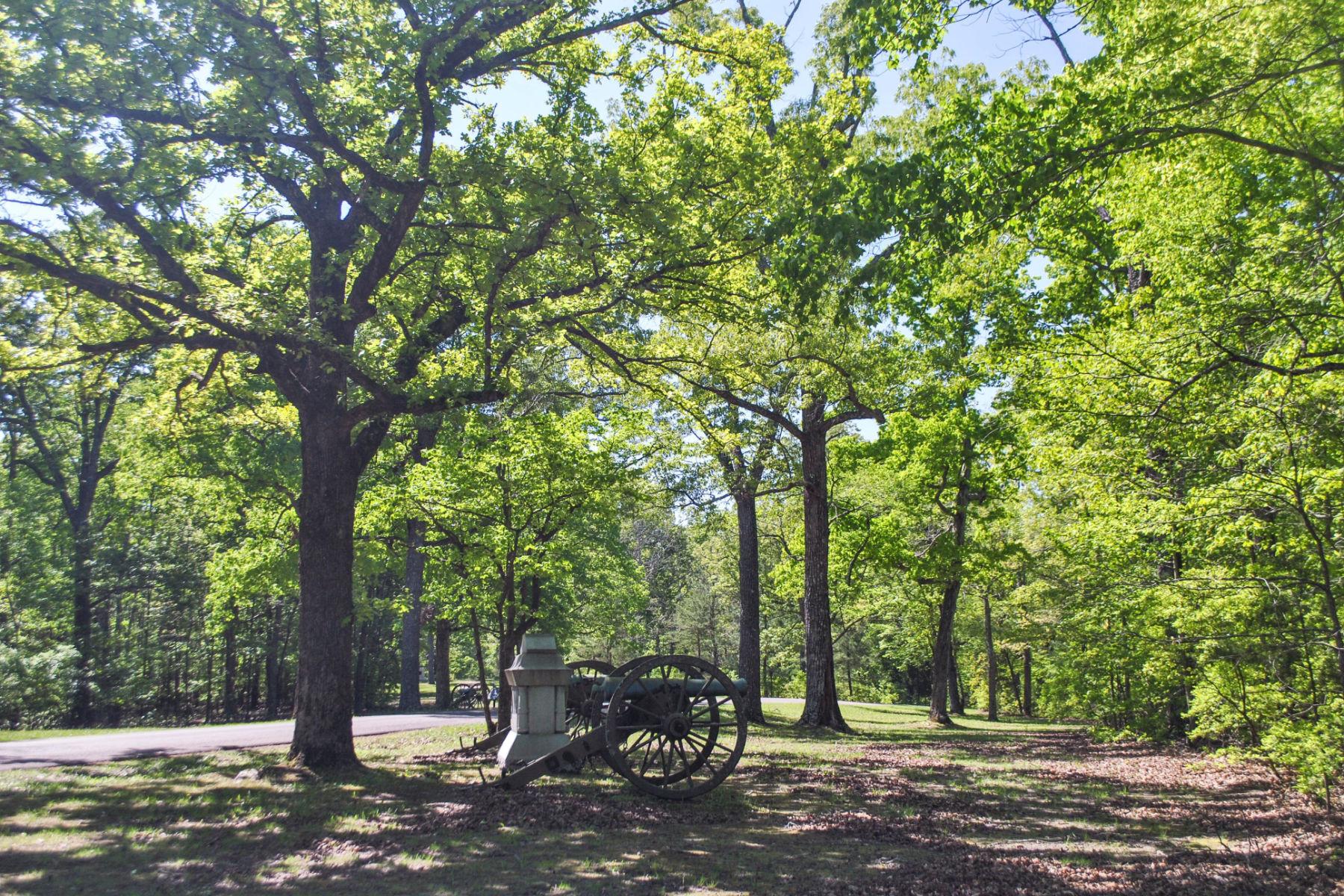
One Of The First Major Battles Of The Civil War
The battle was significant because it was one of the first major battles of the Civil War fought in the western theater and it resulted in a Union victory.
Shiloh National Military Park was established in 1894 and it preserves the sites of the battle, including the Shiloh National Cemetery which holds the remains of soldiers who died during the battle.
The park is open to visitors and it offers a variety of interpretive programs and guided tours to help visitors understand the history of the battle and its significance in the Civil War.
Shiloh National Military Park is part of the National Park Service and it is an important historical site that helps visitors understand the history of the battle and its impact on the Civil War.
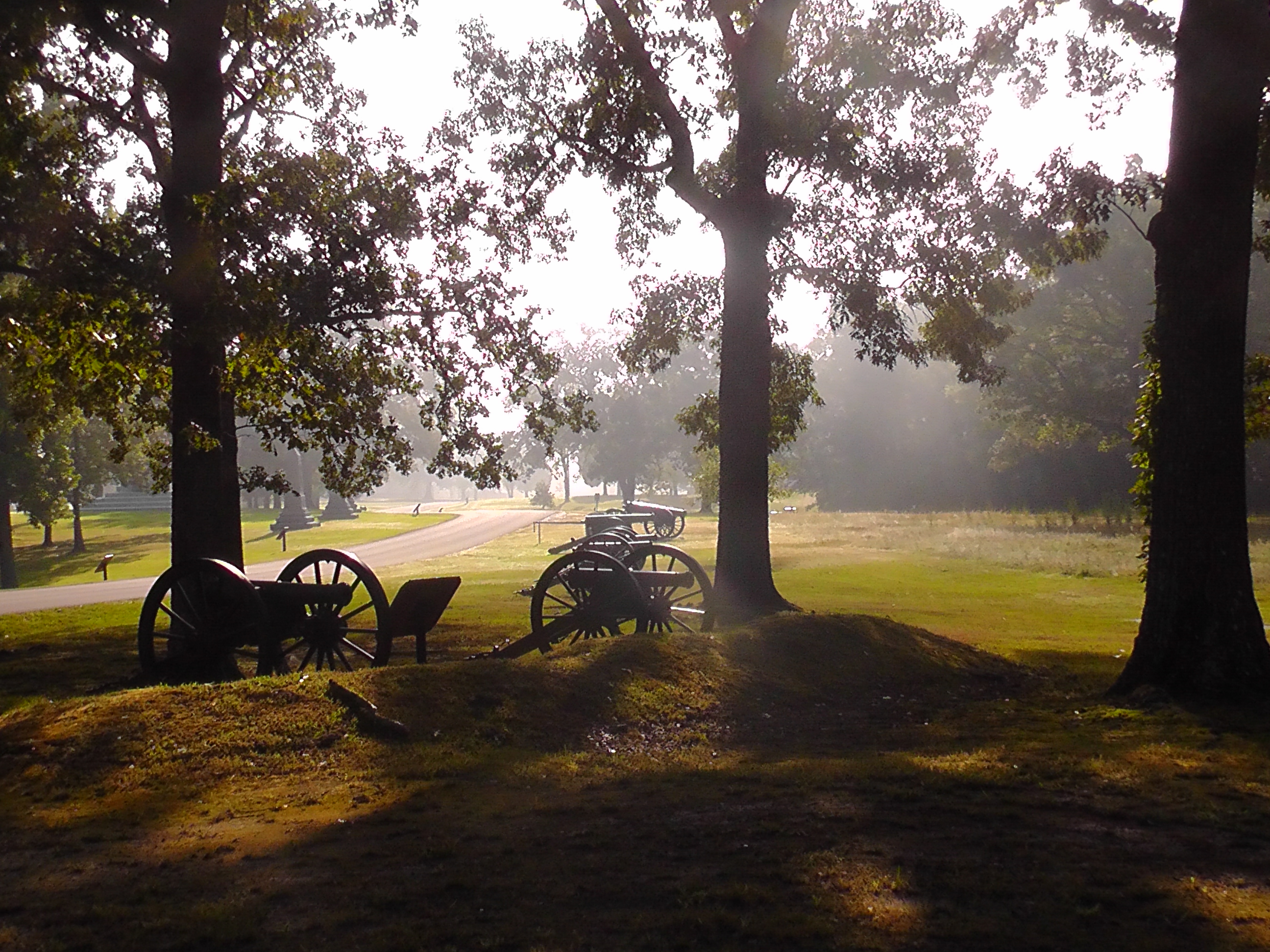
Things To Do At Shiloh
Here are some things you can do when you visit the park:
- Take a guided tour: The park offers guided tours by rangers who provide insight into the history and significance of the battle.
- Visit the museum and visitor center: The park’s museum features exhibits and artifacts related to the battle, including uniforms, weapons, and personal items of soldiers. The visitor center has a movie theater showing a short film about the battle.
- Walk or drive the battlefield: The park has a 12-mile tour road that takes you through the battlefield, where you can see various monuments and markers, and learn about the events that took place during the battle.
- Attend living history programs: The park offers living history programs that feature reenactors who dress in period clothing and demonstrate life during the Civil War.
- Hike the trails: The park has several hiking trails that offer beautiful views of the battlefield and the surrounding area.
- Attend special events: The park hosts special events throughout the year, such as ranger-led programs, Civil War music concerts, and battlefield walks.
- Visit the Shiloh Indian Mounds: Located just outside the park, the Shiloh Indian Mounds are an ancient Native American site that predates the battle.
- Picnic: The park has several picnic areas where you can enjoy a meal surrounded by beautiful scenery.
- Shop at the bookstore: The park’s bookstore offers books, maps, and souvenirs related to the battle and the Civil War.
To Learn More About Shiloh
So many books have been written about the Civil War and the various battles that took place. Of course, the big three authors when it comes to war are, in my humble opinion, Bruce Catton, Shelby Foote and James M. McPherson.
What these three have written are the best collections of books encompassing the war as a whole.
You can’t go wrong with any of these authors. My personal favorite is Shelby Foote. I have read his fabulous three volume history of the Civil War–twice!
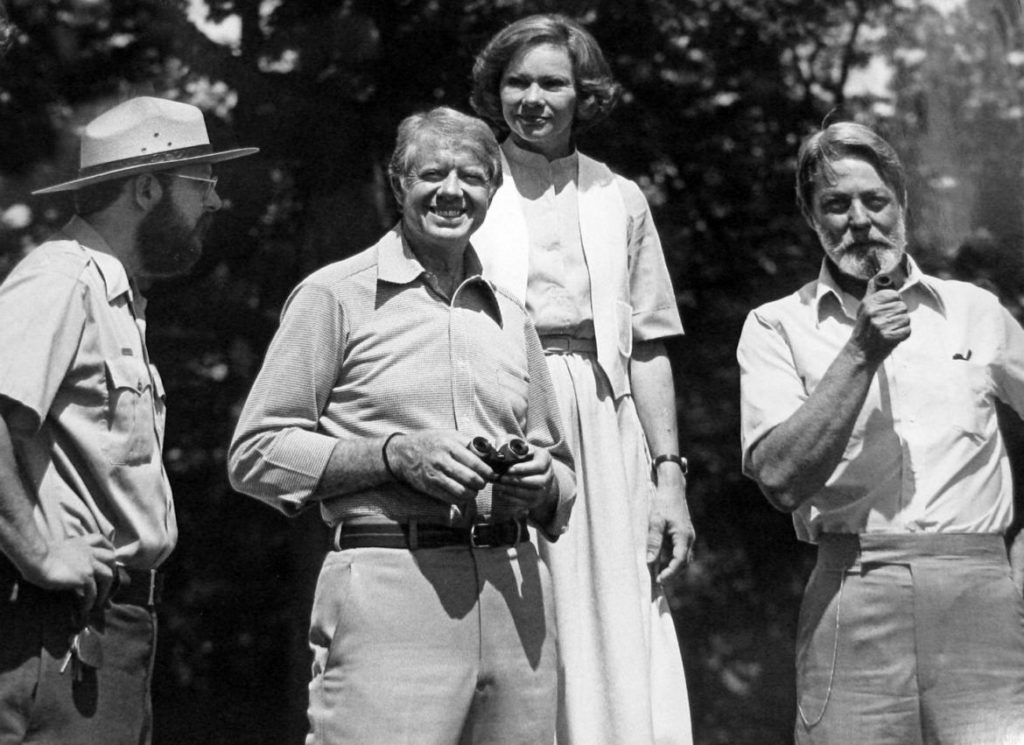
Read About Shiloh
When it comes to the Battle of Shiloh, however, I’m going to recommend three books none of which have been written by the three men mentioned above (please forgive me). I previously recommended one of these and it’s still the best of the bunch in my opinion, but I’m going to recommend it again along with two others.
To gain an understanding of this battle, its strategic importance, and how it influenced the outcome of the war, I recommend:
- Shiloh and the Western Campaign of 1862, by O. Edward Cunningham
- Shiloh, Bloody Shiloh by Wiley Sword
- Shiloh: The Battle That Changed the Civil War by Larry J. Daniel.
Map Of Tennessee Landmarks
List Of Tennessee Landmarks
- Shiloh National Military Park
- Chickamauga & Chattanooga National Military Park
- Overmountain Victory National Historic Trail
- Grand Ole Opry
- Fort Donelson National Battlefield
- Manhattan Project National Historical Park
- Trail Of Tears National Historic Trail
- Cumberland Gap National Historical Park
- Natchez Trace Parkway
- National Civil Rights Museum
- Stones River National Battlefield
- Andrew Johnson National Historic Site
- Graceland
- The Hermitage
- Beale Street Historic District
- James K. Polk House
- Sun Record Company
- Rock City
- Dollywood
- Tennessee State Capitol
Why Trust Us About Tennessee Landmarks?
We’re Jim Pattiz and Will Pattiz, collectively known as the Pattiz Brothers and we absolutely LOVE the national parks.
You should probably know that we don’t just make this stuff up out of thin air. We’ve spent our entire adult lives exploring and filming America’s national parks and public lands.
We’ve worked with the National Park Service, the Department of Interior, USDA, U.S. Forest Service, and more for years creating films on important places and issues. Our work has been featured in leading publications all over the world and even some people outside of our immediate family call us experts on the national parks.
And, in 2018, our father – having spent a lifetime teaching history – joined us so that he could help us to tell the stories behind these amazing places.
Meet The Parks Brothers
We Hope You’ll Follow Our Journey

Our goal here at More Than Just Parks is to share the beauty of America’s national parks and public lands through stunning short films in an effort to get Americans and the world to see the true value in land conservation.
We hope you’ll follow our journey through the parks and help us to keep them the incredible places that they are. If you’re interested in joining the adventure then sign up below!
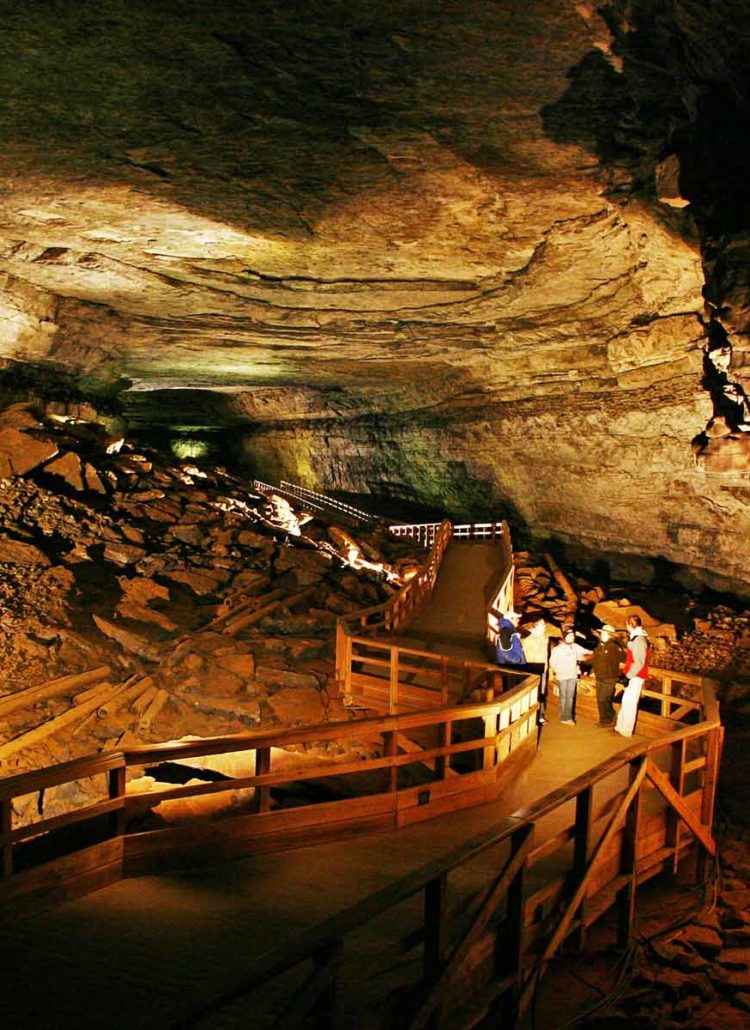
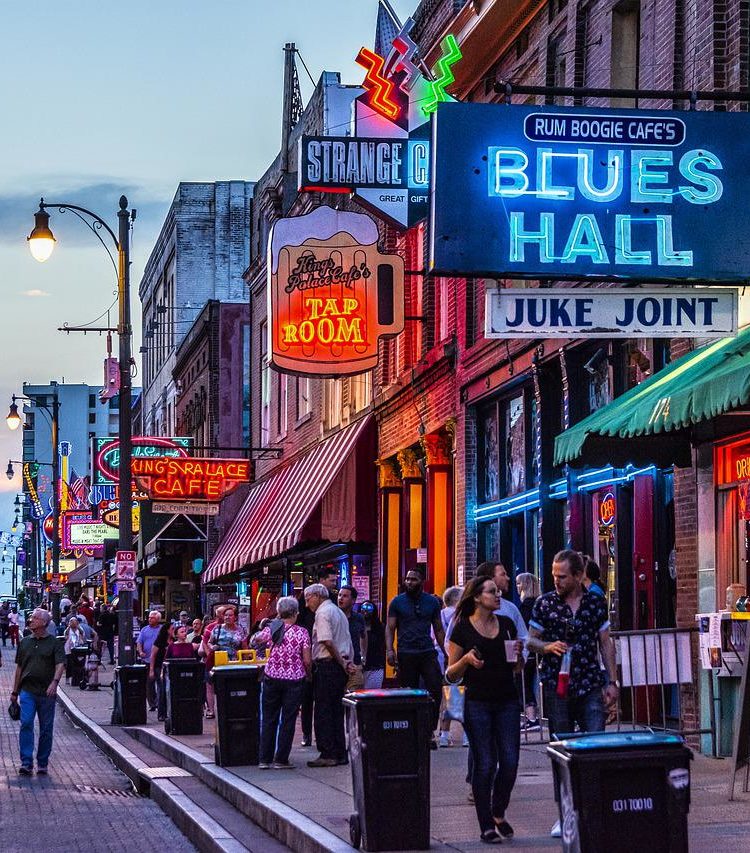
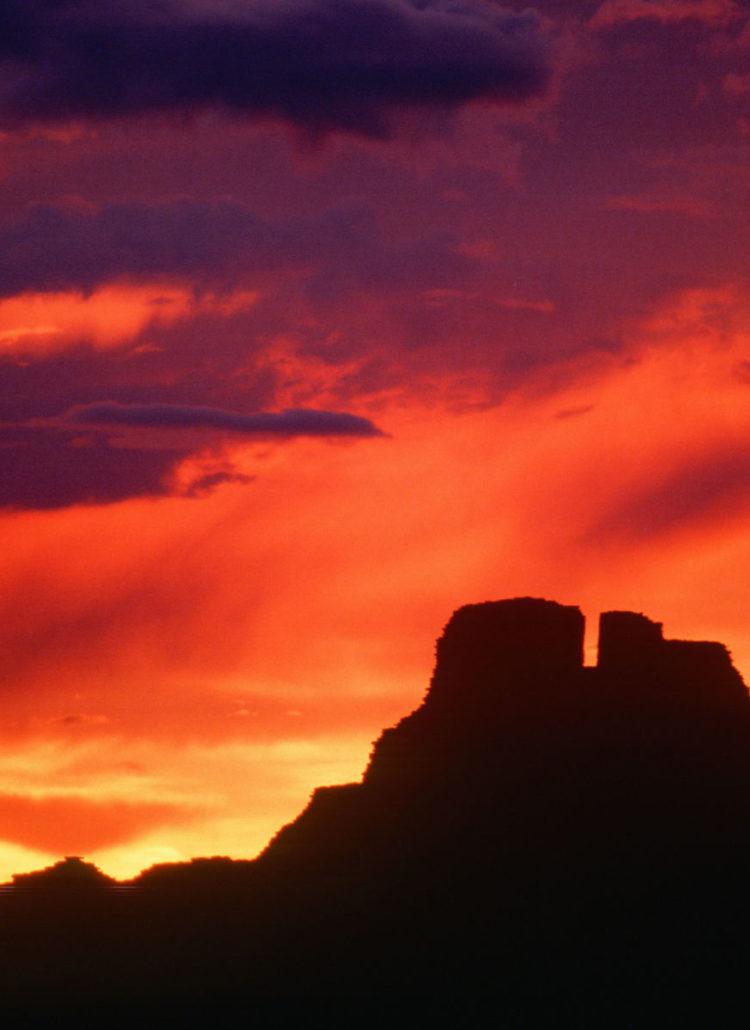
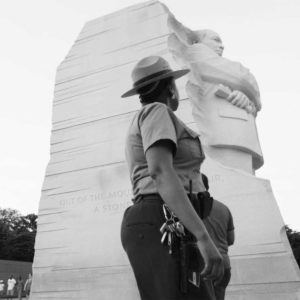

Leave a Reply